

What is Fashion Cycle | 5 Stages of Fashion Cycle with Graph
What is Fashion Cycle? In the world of luxury fashion, everything boils down to the fashion cycle. The way of fashion change is described as fashion cycle. Generally fashion cycle is used to explain the process that a type of fashion goes through. It is the amount of time which takes a fashion trend to emerge, peak and fall out of style. At first fashion gains acceptance from the consumers and by the changing of time the tastes and preferences of the consumers would decrease and gradually fashion lose the acceptance. Fashions do not always survive from year to year. Fashion cycles start when fabric manufacturers present their new samples of materials. They offer new colors, new fabric touches, and new designs.
On the other hands, We can explain fashion cycle is the cycle of fashion industry that goes from its rise, peak, decline and then abandonment of a particular fashion method, mode, trait or preference.
Fashion Cycle Stages: Fashion moves through different stages during its cycles of existence. Fashion acceptance is generally called as a fashion cycle. The fashion cycle is usually represent as a bell shaped curve with 5 stages.
- Introduction
- Rise in popularity
- Peak of popularity
- Decline in popularity

1. Introduction stage: Every fashion designer has each season works on a new collection, interpret their research into apparel. Designs first previewed during fashion weeks at the major design centers. Then designers create new designs by changing elements such as shape, line, color, fabric, and details and their relationship to one another. In this stage product costs are high and as a result only few consumers can afford it. Production in small quantities gives a designer more freedom, flexibility, and room for creativity. Celebrities, TV stars, models buy these clothes as they want to wear them in some events.
2. Increase in Popularity: If new styles are seen worn by celebrities or famous personality on TV or magazines it may attract the attention of buyers, the press, and the public. In this case viewers become interest to purchase to buy the new styles. Some designers or stylists may modify or copy a popular style. Manufactures use less expensive fabric and modify the designs to sell in low price. Mass production reduces the price of the fashion, and become more sales.
3. Peak of Popularity: Fashion at this stage is most popular, it may be in such demand that many garment manufacturers copy it or produce adaptations of it at many price levels. It can survive longer if the fashion becomes a classic. In this stage manufacturers carefully study trends because the consumer will always prefer clothes that are in the main stream of fashion.
4. Decline in Popularity: In this stage, consumer demand is decreasing, going down the slope. Many copies are mass produced that fashion as a result consumer get tired of the style and begin to look for new styles. Fashion items available have saturated the market. They are not willingly to buy with regular price.
5. Rejection of a Style or Obsolescence: It is the last stage of fashion cycle. Consumers are no longer interested in the fashion. In this phase of fashion cycle, some consumers have already turned for new styles, thus beginning a new cycle. Price of the fashion product may be low at this point, but consumers may not buy the product. The rejection of a style just because it is out of fashion is called consumer obsolescence.
Fashion Cycle Lengths: Fashion Cycles have no specific lengths. But we can give specific cycle name with type of acceptance.
- Flop Cycle- No acceptance
- Fad Cycle- Short acceptance
- Normal Cycle- Medium acceptance
- Ford Cycle- Strong acceptance
- Classic Cycle- Continuing acceptance
You may also like: What is Fashion | Classification of Fashion and Its Description

Editor of Fashion2Apparel. She is a fashion designer and ex-lecturer in Fashion Designing. She wants to spread fashion knowledge throughout the world.
Share this Article!
Related Posts

How Fashion Clothing Embellishes Your Personality

What is Fashion | Classification of Fashion and Its Description

Visual Merchandiser: How to Become, Career Path and Opportunities

Color Selection Techniques for Fashion Designers
2 thoughts on “what is fashion cycle | 5 stages of fashion cycle with graph”.
Tq for sharing the different stages of fashion life cycle..
Thanks, very educative.
Leave a Comment Cancel Reply
Your email address will not be published. Required fields are marked *
Save my name, email, and website in this browser for the next time I comment.
Notify me of follow-up comments by email.
Notify me of new posts by email.
This site uses Akismet to reduce spam. Learn how your comment data is processed .
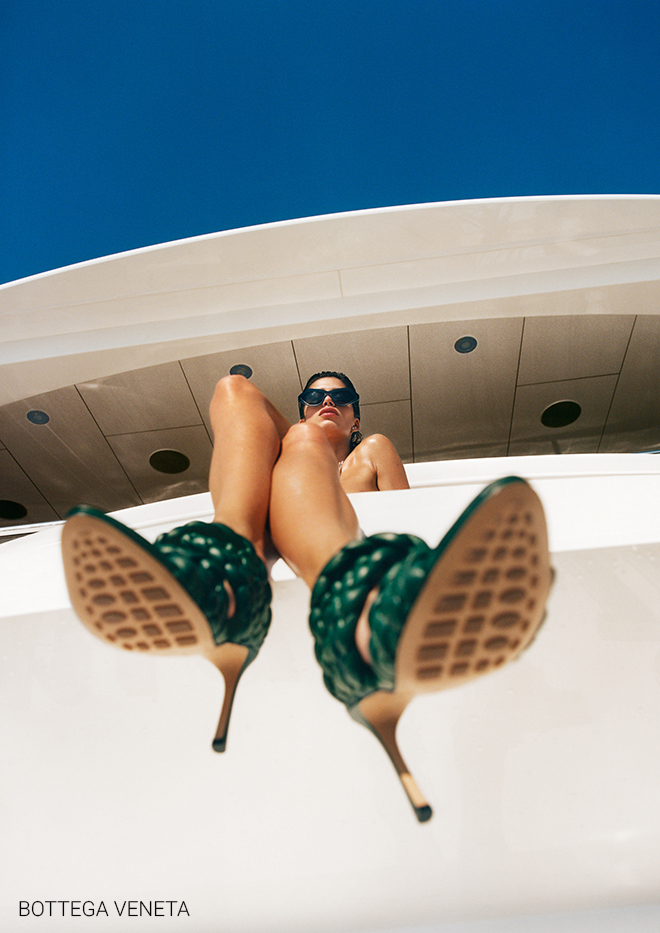
Understanding fashion trend life cycles: The 5 stages
Key takeaways.
- A fashion trend’s life cycle can be divided into five stages, generally speaking: introduction, rise, peak, decline, and obsolescence.
- The life cycles of fashion trends today have changed; technology and social media have rendered them much shorter and less predictable than in the past.
- Luxury and fast-fashion brands move through the trend life cycle differently, and trend forecasting can help decode collection decisions based on differing trend behaviors.
For a long time, it was commonly said that fashion trends circle back every two decades. In the industry of before, twenty years was enough time for a trend to rise to popularity, fade away for long enough to be forgotten, and return again with a modern twist.
While the 20-year cycle remains true to an extent, the advent of innovative technologies and social media has drastically condensed the life cycle of trends today. Styles from every decade make appearances at seemingly random moments, and a multitude of styles can be popular at the same time. Design and merchandising technologies have greatly reduced the speed-to-market, and social media makes it so trends rise and fall overnight.
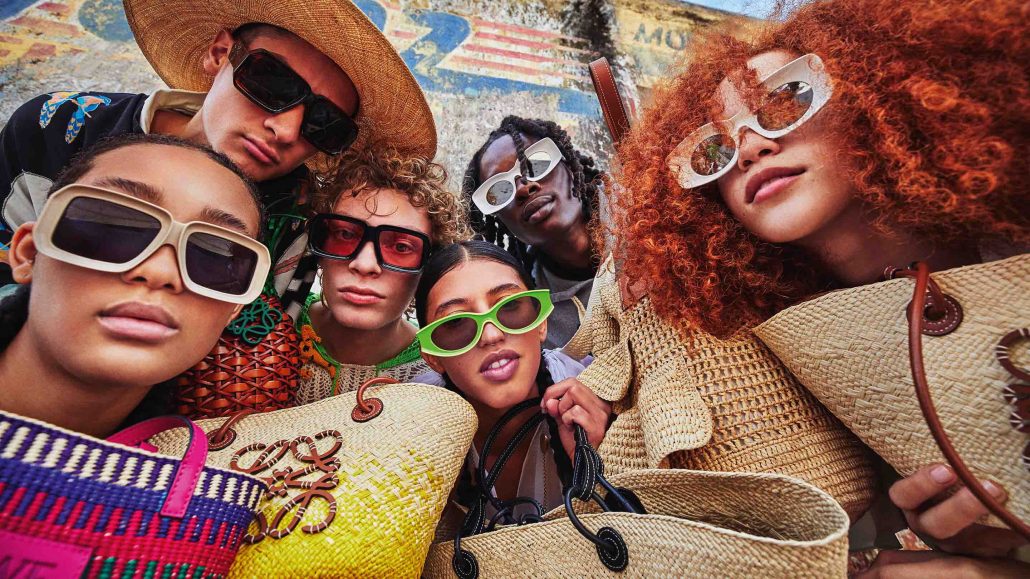
Trends today also originate from myriad sources, including celebrities and influencers, runways, textile manufacturers, social media, music, and more. Their appearance and disappearance are calculated by designers, but also by outside parties like stylists and trend forecasters. A trend may rise to popularity for one reason and fall out of favor for another. Trends are an at times unpredictable phenomenon, but certain behaviors remain true. Indeed, the life cycle of a trend consists of five stages:
- Introduction
- Obsolescence
1. A new fashion trend is introduced
The first stage of a trend’s life cycle is initiated when the new style is introduced. This can be a silhouette, color, pattern, fabric, and more. During this stage, the origin of the trend typically finds itself at the hands of a major brand or designer during the on-season of Fashion Week.
Valentino’s FW22 collection, for instance, featured a particular shade of pink labelled “neon pink” by Heuritech’s fashion experts .
Following the collection’s debut, this shade of pink exploded in popularity and is now considered an established trend for this Winter 2023 among women in the USA, with a significant +44% growth compared to last year.
Right: Valentino
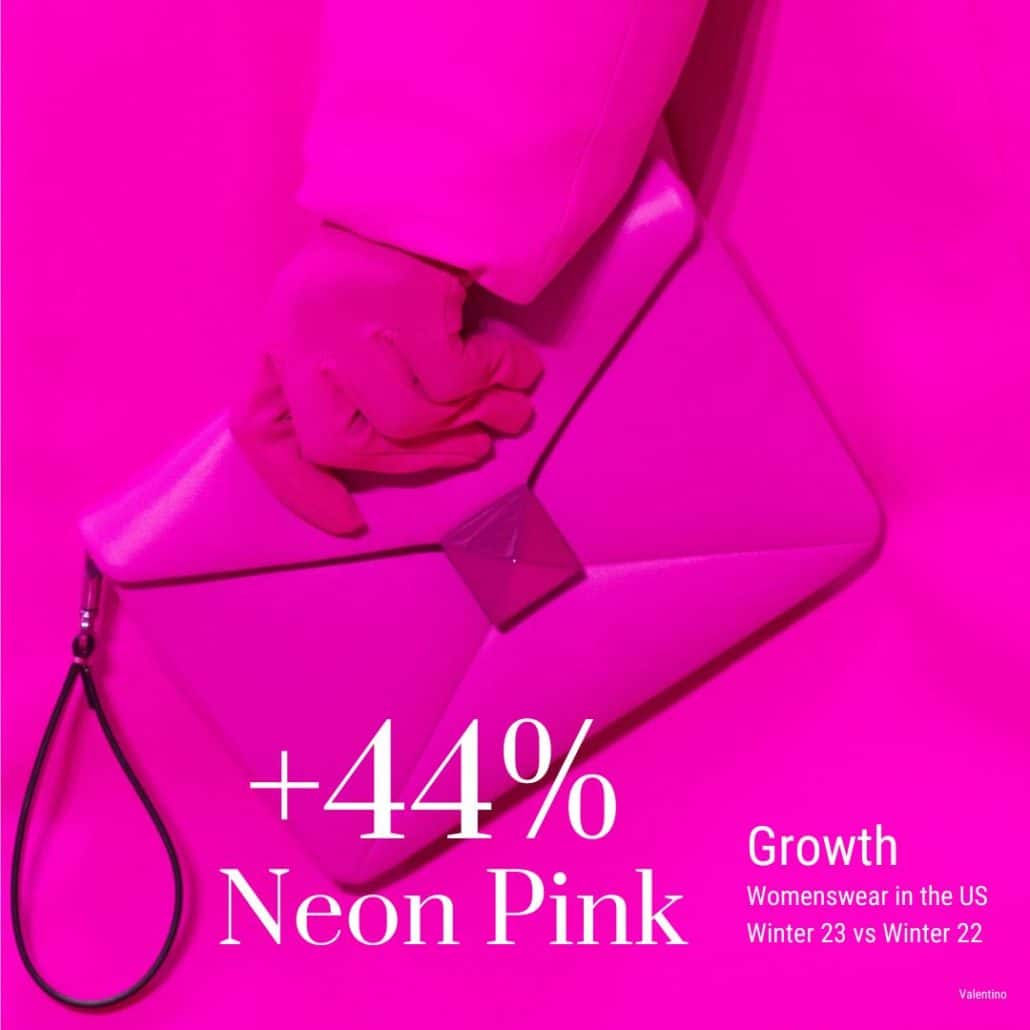
While not all new trends rise to such impressive popularity, it goes to show that when a major brand makes the introduction, there is often a higher chance of a trend finding success among other high-fashion and luxury brands before it trickles down to retailers and fast-fashion brands.
Design and merchandising technologies have greatly reduced the speed-to-market, and social media makes it so trends rise and fall overnight.
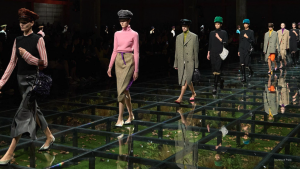
Report | FW ’24 Women’s Fashion Week
Download the report
New trends can also be introduced by grassroots styles, like consumers’ penchant for DIY fashion which was born from the global lockdowns in 2020. And like so often during the introduction stage, the visibility of a trend is born from a niche target audience, either high-fashion or edgy consumers .
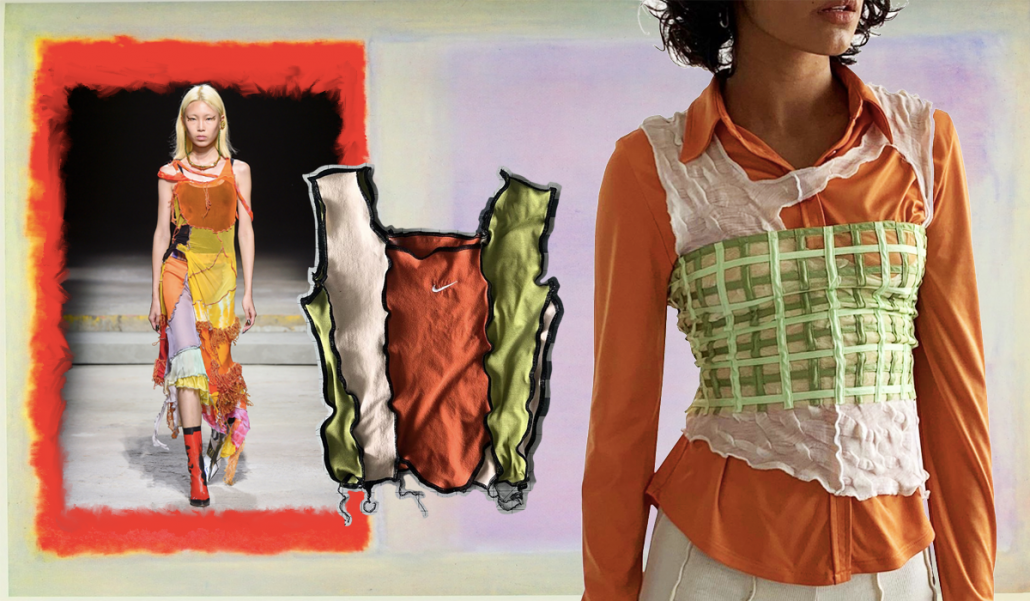
This is also the reason why trends at this stage exist in small quantities at only a few retailers, because mass production only comes once a trend’s relevance is assured by a significant amount of consumers. It’s also important to note that new trends don’t always take off; sometimes, they are introduced and then retracted if enough consumers don’t catch on.
2. The rise of a fashion trend
The second life cycle stage is a trend’s rise to popularity, in which a style evolves from simply “new” to “trendy”. Today, this often happens with the help of celebrities and influencers who popularize a style either by paid promotion or genuine appreciation. Stylists and media strategists often play a big role in this form of popularization, calculating which influencer will wear what.
An example of this phenomenon unfolded when star Dua Lipa and fashion influencers like Camille Charriere embraced the trend of sturdy, buckle-clad biker boots at the inception of 2022, prominently featuring them in their social media posts and public appearances. By the close of 2022, our trend analysts documented an impressive 34% surge in the popularity of buckled boots for Winter 2023 compared to the preceding year, notably gaining traction among fashion-forward women in China.
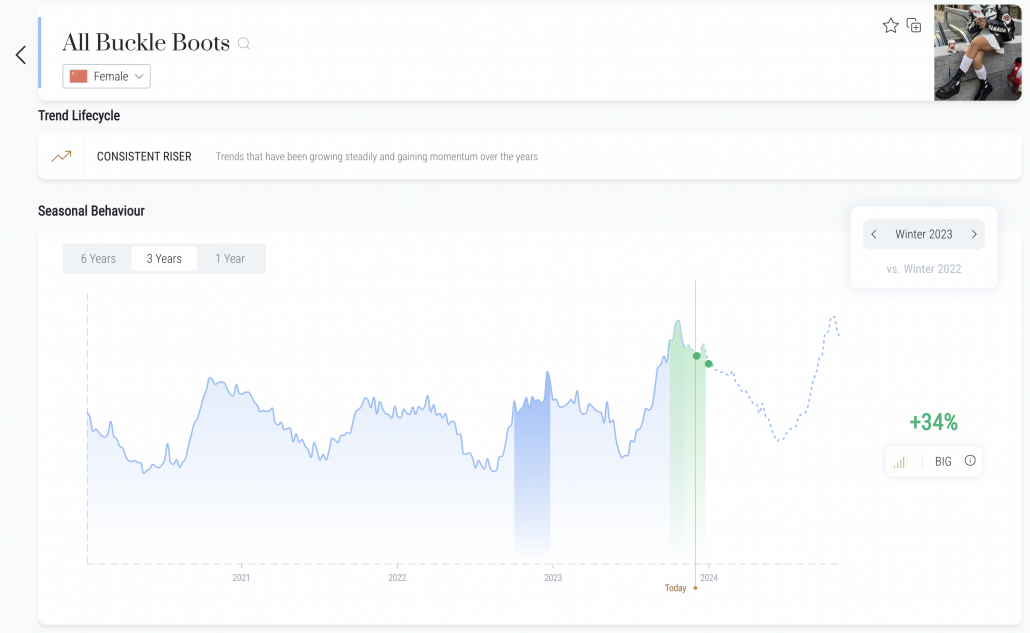
The influence of celebrities and influencers is undeniable.
Understanding the pathway of trends from one geography to another is crucial. The interconnected world of social media and global fashion events plays a pivotal role in this cross-cultural exchange. As celebrities and influencers adopt and flaunt these styles, their impact transcends national borders, reaching audiences worldwide.
The power of social media ensures that fashion trends, once exclusive to one region, swiftly become a global phenomenon, captivating audiences and shaping style preferences across diverse cultures.
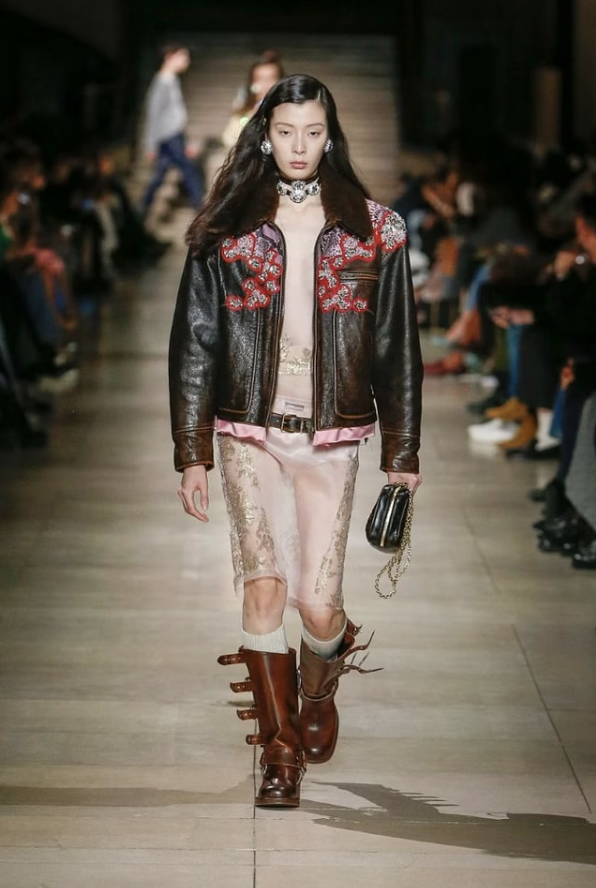
Equally responsible for trend diffusion, as evoked above, is the copycat phenomenon. We saw with the platform heel how high-fashion trends also propagate through copying, in which bridge and fast-fashion brands iterate the trend themselves for a wider customer base.
Miu Miu’s fall/winter 2022 collection featured a biker boot that garnered significant attention. The boot was sturdy, embellished with prominent buckles, and radiated a bold attitude. Miu Miu’s creation established the trend for the season, inspiring many other brands to follow suit and release their own versions of biker boots.
By autumn 2023, the biker boot craze had become a worldwide sensation, with knee-length designs from ZARA and distressed brown boots from ASOS among the most popular.
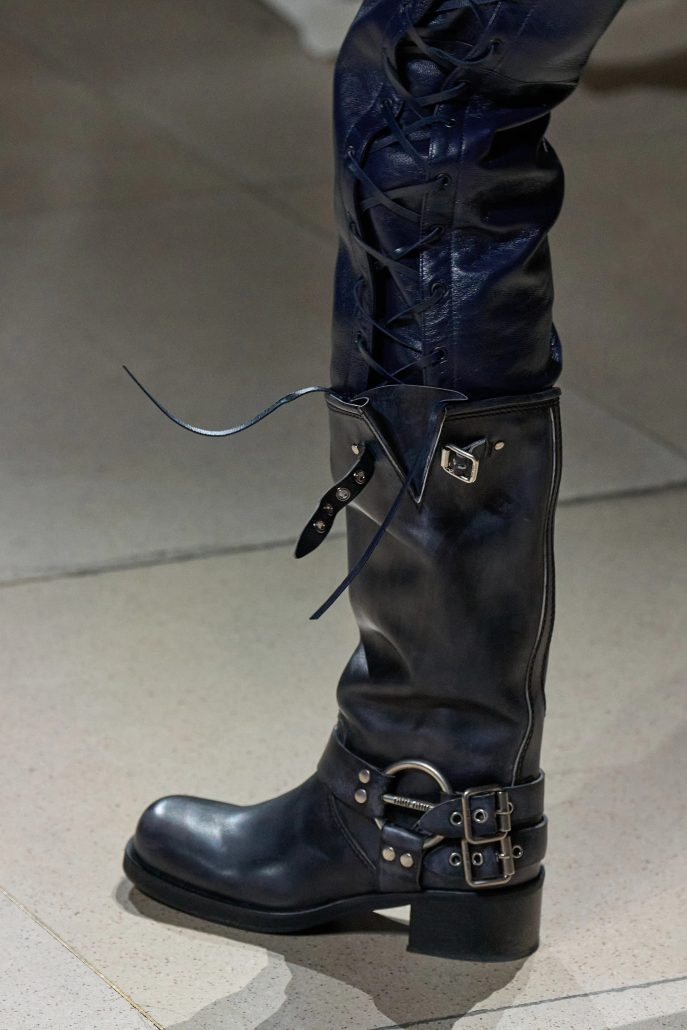
3. The life cycle peak
The peak stage is where a trend reaches the climax of its popularity among a mainstream audience. Most major retailers now carry the trend and render it accessible to all consumer types, often at lower prices than during the increase stage, and most luxury brands no longer carry the trend as a result. This is a peculiar time in a trend’s life cycle, because the length of its peak is rather unpredictable.
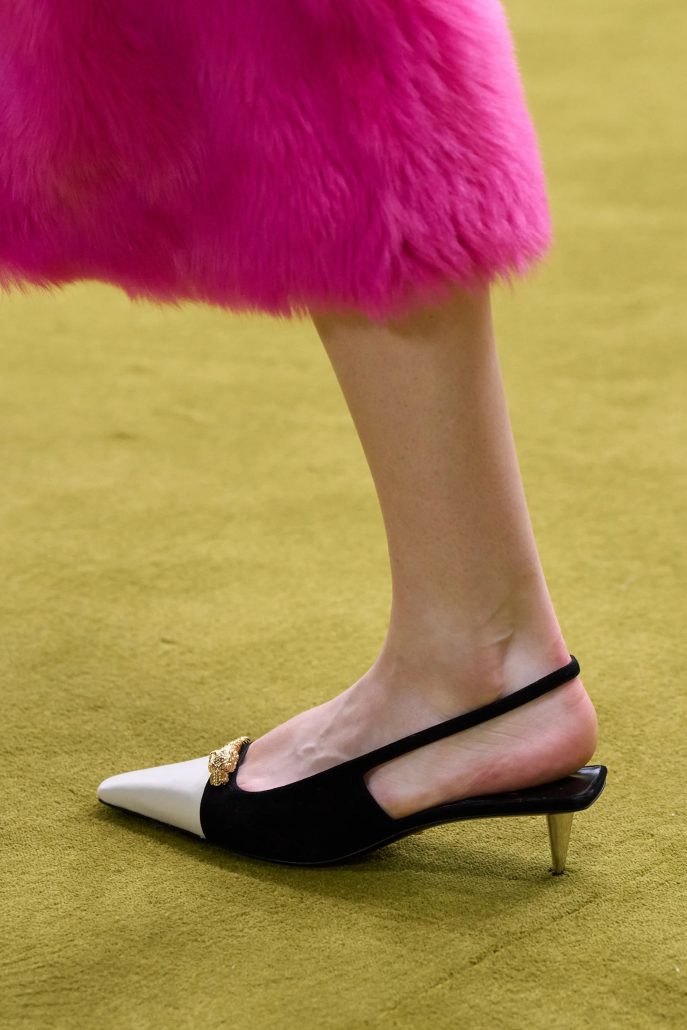
Some trends, like the kitten heel sandal, were popular for only one season in SS21 — Heuritech’s data revealed an 18% decrease between Summer 2021 and Summer 2022 among American women.
Other trends, like ribbed knit fabric, have maintained high popularity for many consecutive seasons — our trend forecasters first noticed the trend in Spring 2020, and predictions for Spring 2022 have ribbed knit fabric at +16% for men in the US.
Left: Gucci
This is where trend forecasters can provide useful data to fashion brands who must know season-to-season how an increasing or popular trend will fare in the coming months. A trend that’s predicted to decrease in popularity the next season won’t be included in the brand’s upcoming collection, for example, leaving more room for new trends to take their place.
Here, high-fashion and luxury brands tend to be at least one season ahead of their bridge and fast-fashion counterparts. This is because they’re often the ones introducing new trends, and they tend to steer away from mainstream appeal in order to maintain their “trendsetter” status. At its peak, a trend is usually no longer carried by luxury brands in lieu of fast-fashion brands pushing these styles.
4. Trends must decline
On a related note, the decline stage closely follows the peak stage because it lives behind the fine line of market oversaturation. A trend’s widespread popularity is often its downfall, because consumers tend to grow tired of seeing too much of a trend, or start to feel too “mainstream”.
The previously-mentioned kitten heel is a good example of this — with external factors influencing the trend’s popularity, namely the Sex and the City reboot and the return of Y2K fashion, the Plain Mini Skirt rose so quickly that consumers grew bored of it just as fast. When this happens, luxury brands keep the trend for one or two seasons only, and retailers begin to sell the trend at discounted prices before eventually phasing out the trend entirely.
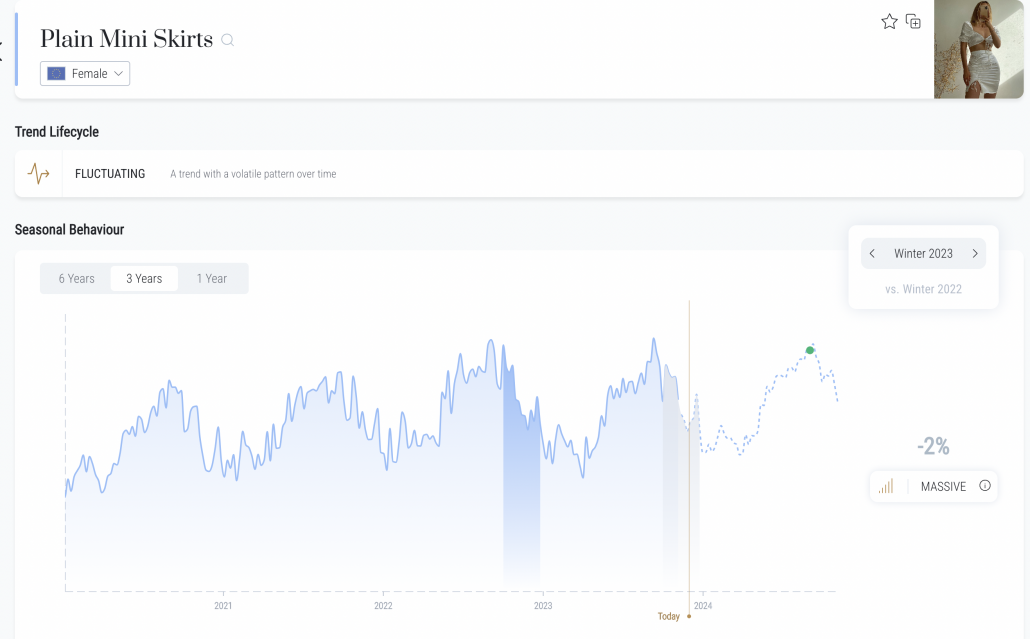
5. The obsolescence of a fashion trend
The final stage of a trend’s life cycle is called the obsolescence stage, during which a style becomes widely labeled as “out of fashion”. Consumers who shortly before enjoyed the trend move on to new peak trends and leave the obsolete trends behind.
Back in 2015, for instance, you couldn’t walk outside without seeing a bomber jacket — high-fashion brands like Helmut Lang, Rick Owens, and Balenciaga saturated their collections with the style, and fast-fashion brands like H&M and Topshop quickly followed. A few seasons later, we saw a rapid decline in the bomber jacket trend before it ultimately disappeared from retailers’ clothing racks.
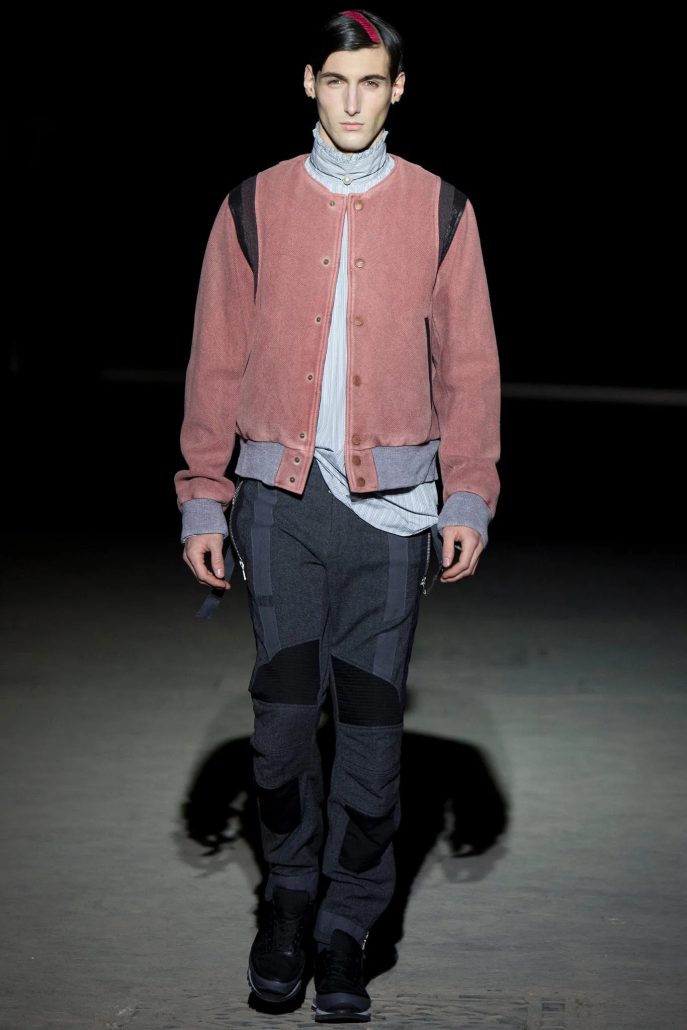
But an “obsolete” trend doesn’t necessarily imply that it won’t return to the fashion cycle; often, past trends are revamped to fit the current moment and once again experience a full life cycle. Despite its 5-year absence from the market, the bomber jacket is already back — in the Fall Winter 2023 collections, a variety of brands, including Diesel and Martine Rose, presented their iterations of the trend.
Indeed, Heuritech’s Winter 2023 predictions reveal a 26% increase in the demand for bomber jackets among women in the USA compared to the Winter 2022 data. Following the typical trend life cycle, we can expect to see bomber jackets among retailers and fast-fashion brands in the coming seasons.
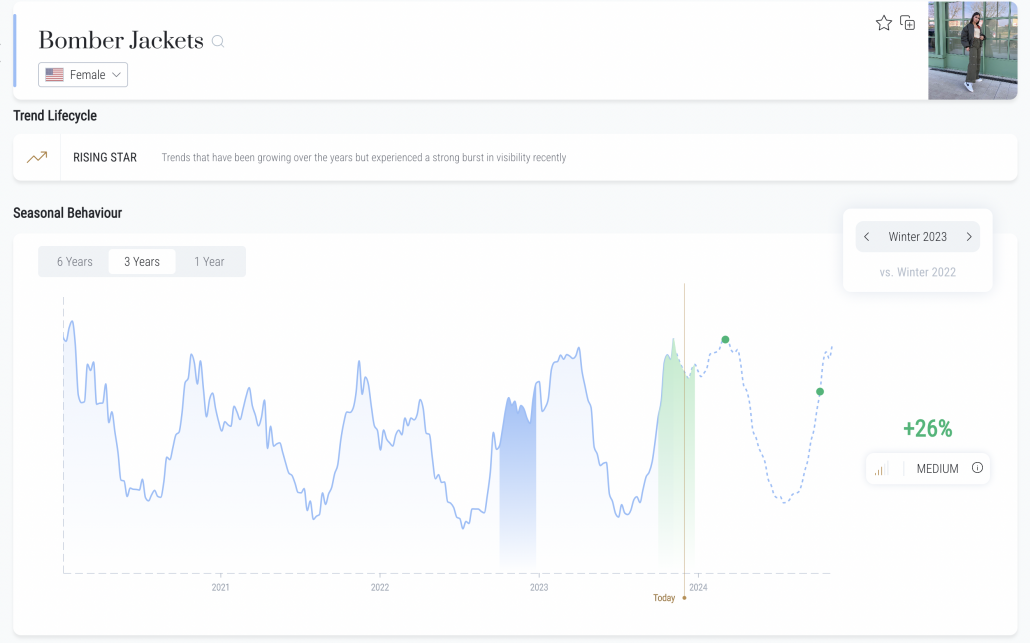
The circle of fashion trends
While the life cycle of a trend can’t be predicted with 100% precision, it is possible to ascribe certain patterns to it in order to better navigate market changes. Again, the general life cycle of a trend is as such:
- Obsolescence
With this model, fashion brands are better able to make collection decisions that will satisfy their customers. Luxury and fast-fashion brands may be on staggered trend calendars from one another, but the usefulness of understanding a trend’s life cycle remains the same.
Furthermore, trend forecasting contributes an extra level of precision to collection-making. Each trend moves through its life cycle in a unique way, so real-time data on specific trends is essential to pinpointing their past, present, and future behaviors.

About the writer: Mélanie Mollard, Fashion Content Writer
Mélanie writes about the fashion industry and its many features through the lens of AI and applied data.
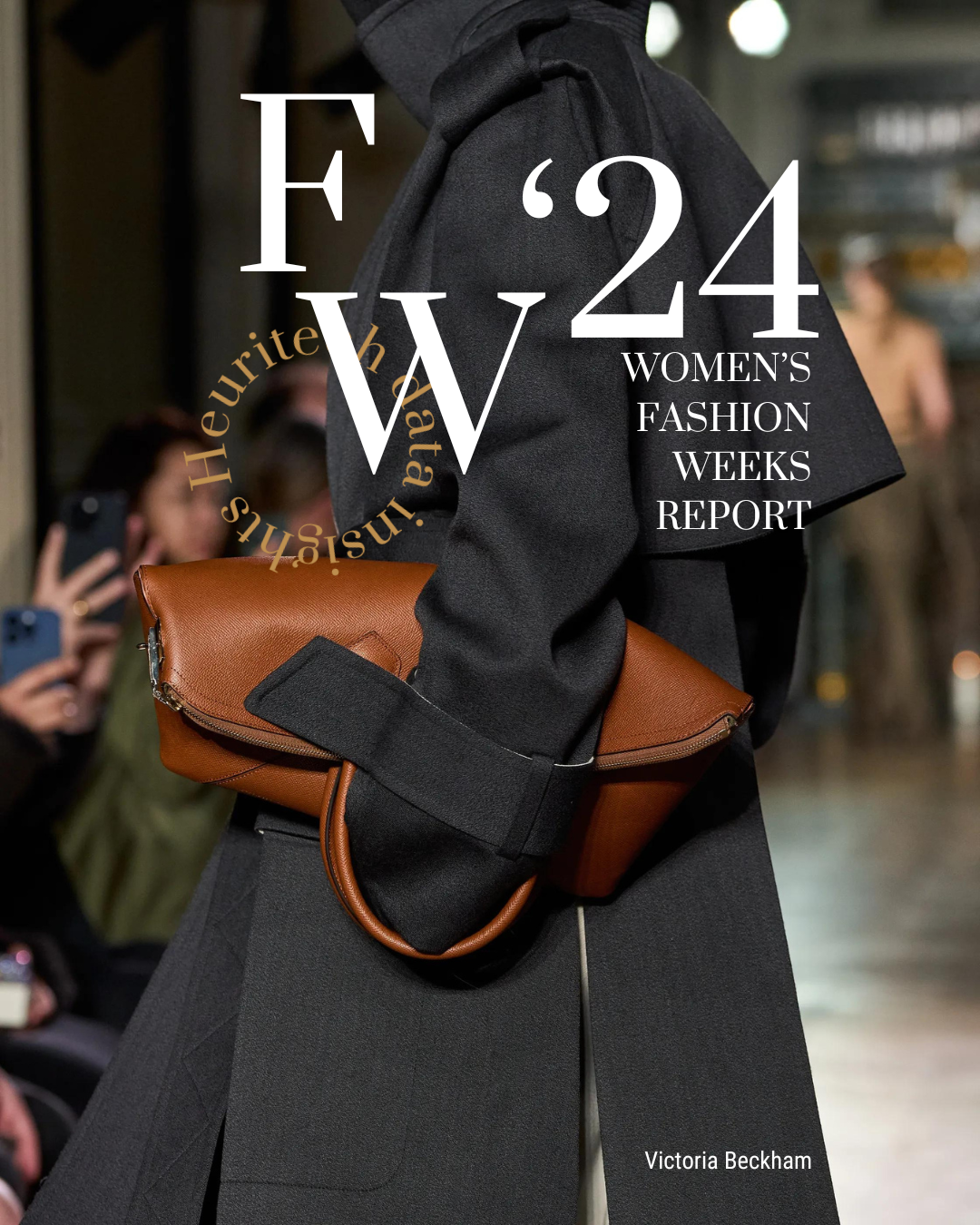
Key data insights from Fall Winter 24 Women’s Fashion Week
Heuritech’s fashion experts study the latest runway styles and then analyse their adoption into the mainstream market using our AI-powered tool. Through a series of key questions, this article explores how these data-driven insights assist various departments to leverage these insights.
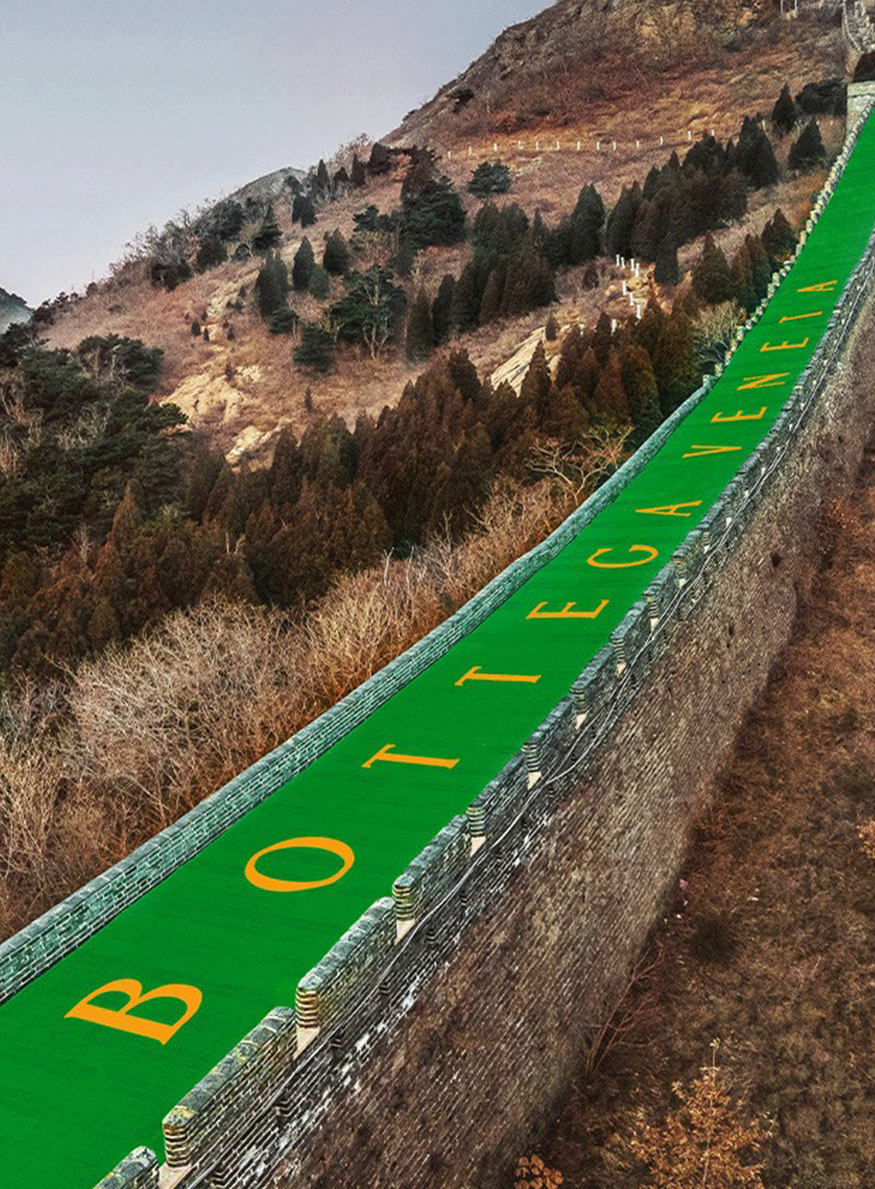
Mastering the Lifecycle of a Trend: The Kelly Green Phenomenon
In the vibrant realm of fashion, the adeptness to decode and respond to the lifecycle of a trend is paramount to a brand’s triumph. The journey of Kelly Green serves as a textbook case on how a trend rises, peaks, and eventually wanes.
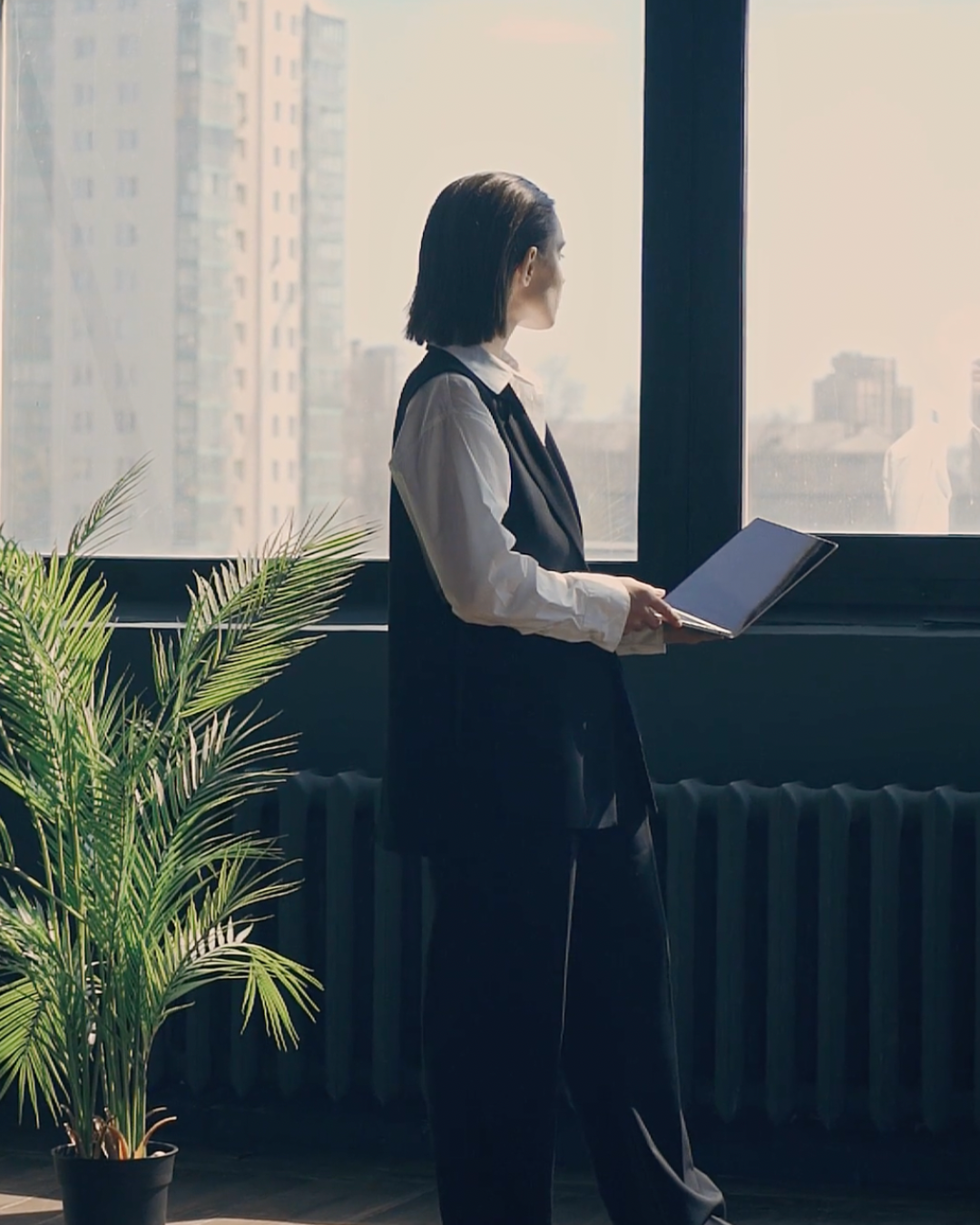
Heuritech’s Decade of AI Excellence: A Transformative 2023
As we bid farewell to an incredible 2023, at Heuritech we proudly reflect on a decade of AI expertise, marking our journey from creation in 2013 to becoming a leader in fashion technology. This year was a testament to the constant balance between our AI prowess and the keen insights of our fashion experts. This synergy of data and fashion expertise continues to fuel the landscape of fashion analytics.
Get contacted by one of our experts
AI-powered insights to back fashion & sportswear players intuitions
ABOUT US CAREERS MARKET REPORTS
PRICING REQUEST A DEMO FAQ
Press inquiries: [email protected]
© 2024 ALL RIGHTS RESERVED - HEURITECH | PRIVACY POLICY | TERMS & CONDITIONS | 6 rue de Braque, 75003 Paris

- My presentations
Auth with social network:
Download presentation
We think you have liked this presentation. If you wish to download it, please recommend it to your friends in any social system. Share buttons are a little bit lower. Thank you!
Presentation is loading. Please wait.
Fashion Cycle.
Published by Elmer Barker Modified over 5 years ago
Similar presentations
Presentation on theme: "Fashion Cycle."— Presentation transcript:
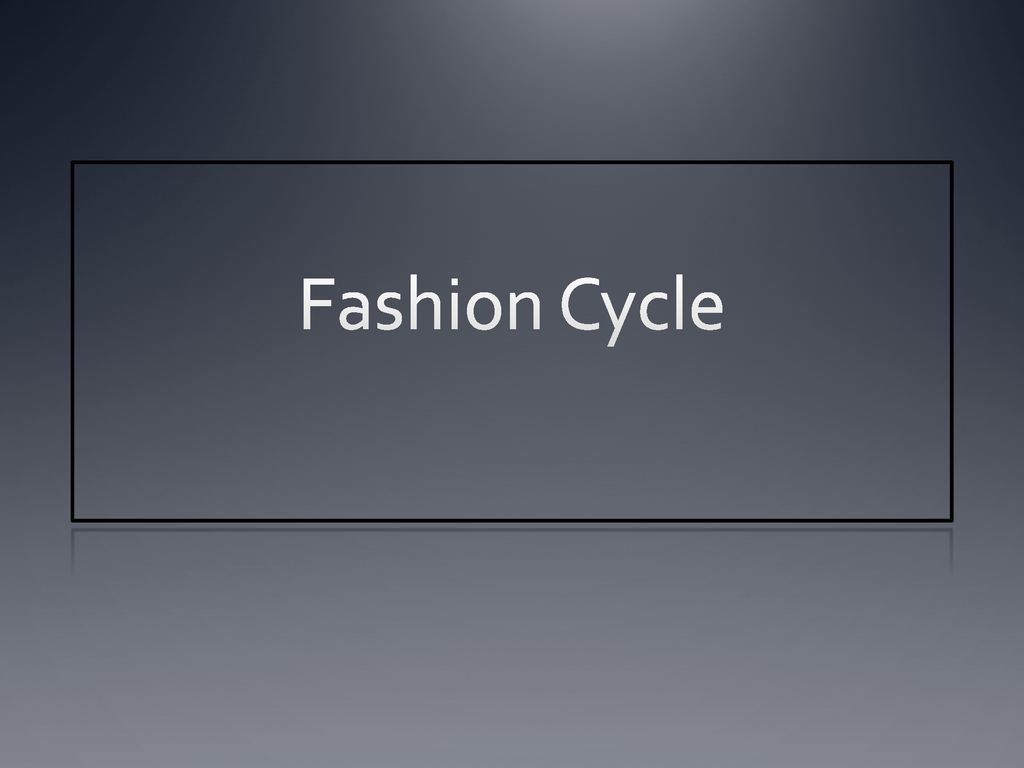
11.02 – The Fashion Cycle May The Fashion Cycle 1. terms – Avant-garde - the advance group in any field, esp. in the visual, literary, or musical.

THE WORLD OF FASHION MERCHANDISING

The Fashion Cycle.

UNIT B EVOLUTION AND MOVEMENT OF FASHION

Frings: Fashion From Concept to Consumer, 9 th ed. © 2008 Pearson Education, Upper Saddle River, NJ All Rights Reserved.

Fashion Styles Fashion Design, Textiles & Merchandising.

Fashion Vocabulary.

Fashion Forecasting. Know your Customer!! Government sources of information Business publications Resident buying offices Non-competing stores Vendors.

Fashion Styles.

Chapter 2 FASHION By Mary Wolfe

Good Afternoon and Happy New Year! 1/2/14 I hope you all had an awesome break! Today we are: – Looking at the fashion cycle Next week: – Marketing – Begin.

What influences what you wear? Celebrities Friends Media Weather Religion Parents.

Product-Mix Strategies

Fashion & The Fashion Industry

Standard 3 - Fashion Cycle. S TANDARD 3 – S TUDENTS WILL BE ABLE TO UNDERSTAND THE BASICS OF THE FASHION CYCLE. O BJECTIVE 1 – D EFINE F ASHION T ERMS.

Fashion Merchandising A

Bell Ringer Ramiro has accepted three credit card invitations and now has three cards with limits of $7,000, $5,000, and $9,500. He currently has these.

McGraw-Hill © 2008 The McGraw-Hill Companies, Inc. All rights reserved. Fashion Terminology and the Merchandising Process Chapter Two Core Concepts in.
About project
© 2024 SlidePlayer.com Inc. All rights reserved.
- Business Focus
- Industry Focus
- Sustainability
- Testing & Standard
- Textile & Apparel
- Fashion & Retail
- Conversations
- Dyeing, Finishing & Printing
- Smart Textiles
- Tech & Machinery
- Textile Raw Material
- Technical Textiles

- Denim Focus
- Industry Associates
- Submit Article
- Advertisement
- Subscription
- Event Planner

Md. Imranur Rahman to get export sector CIP status by Bangladesh Govt.
Fashion power group ceo md. mijanur rahman named cip by government, inamul haq khan to get export sector cip status for 8th time, atet next election is set to be held on 1 may, s m shohel rana is going to be..., puma recorded positive sales with 8.6 bln euros in 2023, “khadi fest 2024” – a historic monument of bangladesh, the jute revolution stuns the world: a mesmerizing runway of innovation and style, the resurgence of handcrafted textiles: artisanal revival, anwar group is a pioneer in the industry and a leader in development, always striving to diversify products and..., entrepreneurs should focus on 4p business model to make their business sustainable, textile production has declined significantly due to shortage supply of gas, solunaris provides sustainable digital textile printing solutions, warp tension under control and a bright future ahead, recycled fibres: the machinery and services, browzwear extends its library of colors to empower 3d fashion workflows with color atlas by archroma®, aver and shin kong security revolutionize remote healthcare, intertek launches innovative traceability and sustainability platform with trace for good, freudenberg’s sant’omero site implements zdhc, new study reveals fashion retailers and brands are exploring sustainable packaging but there’s room for improvement, cemvision raises €10m in landmark climate tech seed round, bureau555 awarded vizoo scanning hub certification, breaks ground in material digitization movement in bangladesh, enhancing recycled post-consumer textiles: innovative technologies for promoting sustainable fashion, minimalism: a new fashion concept for simplicity, utility and elegance, suedwolle group launches the new activeyarn® collection, chattagram textile engineering college alumni association (ctecaa) organised get together and iftar mahfil, skylark soft limited rekindles partnership with textile focus to propel textile and rmg sector forward, al shahriar is announced as panel leader for upcomming bgapmea pools, a brief introduction of the five-stage fashion cycle.
Mohammad Nurul Alam
“Fashion is part of the daily air and it changes all the time, with all the events. You can even see the approaching of a revolution in clothes. You can see and feel everything in clothes.” — said Diana Vreeland, A French-American fashion columnist and editor.
This means fashion is ever changing and here time turns it old and introduces with new one. And fashion cycle refers to the process by which a particular design, activity, colour, etc., comes into some popularity and then phase out from the mind of commoners. This cycle of fashion when observing its different stages and getting adopted or rejected by the masses people fashion completes its theory of life cycle. The life cycle of fashion trends has been changed by the development of technology and the use of social media and rendering the cycle much shorter and less forecastable than in the past. However, a fashion trend’s life cycle can be classified into five.
- Introduction
- Decline and
- Obsolescence.

Fall/Winter 2023-2024 trends: back to the quintessential style. The quintessential style came back with the initiations of some major houses that presented landmark collections on the catwalks of the Fall/Winter 2023- 2024 Fashion Week. Quintessential trend paradoxically stems from a desire to assert a creative heritage. (Source Numero )
1) Introduction of a fashion trend cycle
Fashion begins in the mind of a designer or someone who wants change then it goes to public view but no all time the new idea is being accepted by commoners. Some lost their appeal to the end customers and some go viral in society, the community or in social media. If the design and new concept are accepted, then the introduction cycle period of fashion trends begins for a particular style.
Impotent notes for the Fashion cycle.
- The introduction phase begins when a new style is being introduced to the fashion world.
- This introduction can be part of new haute couture during fashion week.
- The new fashion or outfit is being worn by an influential person such as a celebrity or by well- a known person.
- The new fashion could be an effort of forecast presentation by a marketing agency or manufacturer.
- The style is produced in small quantities by designers or retailers often at high price in the market.
- New fashion is usually introduced by making, changing and adding on basic such as asymmetrical balance, color, fabric, line, sharp, and trimming.
2) Increase in fashion cycle or fashion acceptance
This is the second stage of the cycle known as Growth in Popularity also. When celebrities wear a new dress and then if mass people is influenced or it could draw the attention of buyers and media, that means the second phase begins for a new style.

Pop stars Ariana Grande and Olivia Rodrigo have meaningful activity because they are widely followed by the youngster, while they began wearing platform heels at the start of 2021 in their social media posts and music videos. By the end of 2021, a new trend forecaster 26% rise in popularity of the shoe between Winter 2020 and Winter 2021 among women in Europe. Runway-to-celebrity: Ariana Grande wears the Versace platform heel in yellow. (Source Heuritech)
Important Notes for the Cycle of Growth in Popularity
- Growth depends on popularity or on general acceptance. Designer put higher prices at the beginning of a fashion cycle but in the second phase try to reduce the price to give the new fashion as popular. Because unless the fashion is sold in the common market the popularity is never found.
- The growth may see several weeks.
- The popularity may also depend on copying, and modifications by adding less expensive fabric, and materials and selling at a lower prices by the designer.
- When the new fashion style starts gaining momentum and attraction in the fashion industry then the new fashion officially receives the “Trend” label.
- During the rise stage fashion leaders, and trendsetters wear the dress and put an Influential presence on social and mass media to increase consumer’s demand.
- In response to this mass acceptance by fashion influencers, most retailers and brands generally start carrying the trends.
3) Mature Popularity for a fashion cycle
When a particular design goes to the peak of popularity at the optimum level that means it reaches to the matured stage.

ASOS imitates the Versace platform heel in pink in their Runway-to-retail. Brands and retailers to pick the popular trend by copying and modifications of it to gain profit. Shoe Brands Pretty Little Thing and ASOS started to sell low-cost versions of the Valentino and Versace platform heel, in a wider range for consumers in the common flat form to access in the community and further popularize the trend.
Notes on the fashion cycle of Mature of popularity
- It may create much demand for many brands and retailers to pick the popular trend by copying and modifications of it to gain profit.
- In this stage, retailers step cautiously to understand the trend and mass acceptance of a design before going bulk goods.
- Consumers feedback is most important in this stage and analyzing them will help to know the peak of popularity but taking too much time for analyzing will damage the business opportunity.
- The maturity and popularity also depend on the acceptable popular price. So producers cautiously analyze and do necessary action to get benefit from the stage.
4) Deterioration of the popularity of a fashion
When consumers feel the design is very common and available throughout the season in the shop and as people’s outfits they search for something new and different from others. It means the fashion cycle is reached to its top and begun declining.

Image of kitten heel sandle, Shoe brand of Getty Images. According to Heuritech’s data kitten heel sandle were popular for only one season in SS21 — it revealed an 18% decrease in attraction between Summer 2021 and Summer 2022 among American women. (Source Heuritech)
Exception the ribbed knit fabric could maintain high popularity for many consecutive seasons — Heuritech trend forecasters first noticed the trend in Spring 2020, and predictions for Spring 2022 have ribbed knit fabric at +16% for men in the US. (Source Heuritech)
Notes on fashion cycle Deterioration of popularity
- The declining of popularity turns into an old trend due to the entrance of a new collection
- But the stage still has some demand from the consumers who are waiting for further downfall of price.
- So retailers display the style at their shop to sell at discount and plan for emptying the store before the consumers feel not to buy the goods even at discount.
5) Dismissal of style or ending of the fashion cycle
At stage fourth, the style began to decline its popularity and at stage five the obsolescence phase or ending of trends is observed. In this final stage users absolutely lost their passion for the design and turn to new trends.
Important notes on Dismissal of a style
- The rejection of style occurred just because it is out of fashion and fails to generate customers’ attention.
- Designers and market analyzers stop producing the same design before the dismissal period arrives in the fashioned cycle.
- In place of old trends, new fashion reaches consumers and their trends begin for new fashion and rejecting the old.
In conclusion, it could be said that fashion trend depends on the purchase ability of the mass people and at the same time it could influence people when a famous person wears them. But in general believe, a lost fashion trend can revive after every twenty years the cycle because time changes the mind and test.

Upcoming Events
Simillar news, recent random, atet next election is set to be held on 1 may, s m shohel rana is going to be elected the next president, innovations in hometech textiles: shaping the future of comfort.

Address: House-23 (4th Floor), Road-09, P C Culture Housing, Mohammadpur, Dhaka, Bangladesh. Email: [email protected] Phone: 88 02 48119567, 88 01717585832
News Sections
© 2024 Marketo Services. All Rights Reserved.
- Privacy Policy
- Preferences

The Fashion Cycle - PowerPoint PPT Presentation

The Fashion Cycle
... styles less expensive fabrics used to create similar style at cheaper prices more people wear the fashion = higher sales peak stage fashion ... funny 50 years ... – powerpoint ppt presentation.
- The period of time or life span during which the fashion exists.
- Designs first previewed during fashion week
- Fashion Leaders wear the style
- Limited number of people purchase
- Manufacturers will copy new designer styles
- Less expensive fabrics used to create similar style at cheaper prices
- More people wear the fashion higher sales
- Fashion is most popular at this stage
- Merchandise is mass produced and distributed
- Popularity of style determine how long fashion stays in this cycle
- Will survive longer it fashion becomes a classic
- Changes in design, color or texture keep fashions in this stage (ex Cardigan Sweater)
- Consumers grow tired of the fashion and demand decreases
- Retailers markdown items to increase demand and make room for new designs.
- End of the fashion
- Price of fashion will be low, but consumers still may not purchase
- Trendsetters or individuals who are the first to wear new styles.
- Not afraid to wear something before others
- High profile Celebrities, Models
- Styles are often displayed at award shows, movie premiers
- Wear fashions only when they become firmly accepted
- When available in more retail stores
- When fashion reaches mass acceptance with the majority of the general public
- Last to adopt a new fashion
- Majority of consumers follow rather than lead
- People feel insecure
- Easier to conform to standards
- Lack of time or money for shopping
- Trickle-Down Theory
- Suggests that fashion trends start at the top with consumers of higher socioeconomic status and moves down to the general public
- People with lower incomes (at the bottom of the fashion ladder) will only wear fashions that have become popular among consumers with higher incomes.
- As more people adopt the fashion, those at the top become less interested
- Trickle-Up Theory
- Suggests fashion starts with lower-level income consumers and then moves towards consumer with higher income.
- Lower-income includes younger consumers (teenagers)
- Trickle-Across Theory
- Fashions are accepted at the same time by all socioeconomic classes because there are fashion leaders in all groups.
- 10 years before its time vulgar and indecent
- 5 years before its time bold and shameless
- 1 year before its time flashy and daring
- When its in fashion elegant and smart
- 1 year after its time tacky
- 5 years after its time hideous
- 10 years after its time outrageous
- 20 years after its time funny
- 50 years after its time odd
- 100 years after its time charming
- 150 years after its time - gorgeous
- Mass Media Spreads fashion news around the world instantly
- Good Economic Conditions More money to spend designing and purchasing fashions
- Competition More competition lower prices and better quality
- Technological Advancements Easier quicker to manufacture clothing
- More Leisure Activities Higher need for a variety of clothes (athletic, travel attire, etc)
- Higher Levels of Education more money (sometimes) to spend on fashion
- Poor Economic Conditions Less money less fashion
- Religion Some religious groups feels certain fashion leads to temptation and corruption
- Disruptive World Events Ex. During wartime there may be restrictions on materials or amounts of fabric
PowerShow.com is a leading presentation sharing website. It has millions of presentations already uploaded and available with 1,000s more being uploaded by its users every day. Whatever your area of interest, here you’ll be able to find and view presentations you’ll love and possibly download. And, best of all, it is completely free and easy to use.
You might even have a presentation you’d like to share with others. If so, just upload it to PowerShow.com. We’ll convert it to an HTML5 slideshow that includes all the media types you’ve already added: audio, video, music, pictures, animations and transition effects. Then you can share it with your target audience as well as PowerShow.com’s millions of monthly visitors. And, again, it’s all free.
About the Developers
PowerShow.com is brought to you by CrystalGraphics , the award-winning developer and market-leading publisher of rich-media enhancement products for presentations. Our product offerings include millions of PowerPoint templates, diagrams, animated 3D characters and more.

Sustainable style: How fashion can afford and accelerate decarbonization
Fashion brands, big and small, have made ambitious, public commitments to creating more sustainable apparel by 2030. But keeping pace with their decarbonization commitments has been a challenge across the industry.
About two-thirds of brands, according to a new McKinsey analysis, are behind on their own decarbonization schedules, and 40 percent have seen their emissions output increase since making their sustainability commitments.
Today, the global fashion industry accounts for an estimated 3 to 8 percent of total greenhouse gas (GHG) emissions, and the industry’s emissions are expected to increase by about 30 percent by 2030 if no further action is taken. 1 For more, see Fashion on climate: How the fashion industry can urgently act to reduce its greenhouse gas emissions , Global Fashion Agenda and McKinsey, 2020; and The State of Fashion 2024: Finding pockets of growth as uncertainty reigns , The Business of Fashion and McKinsey, November 29, 2023. There’s a particular sense of urgency for fashion to abate emissions as quickly as possible, since several countries that are likely to experience the greatest devastation from climate change are central to fashion’s value chain. Intense and frequent weather-related events occur in primary manufacturing countries—such as Bangladesh, China, India, and Vietnam—which export an estimated $65 billion worth of apparel. 2 The State of Fashion 2024: Finding pockets of growth as uncertainty reigns , The Business of Fashion and McKinsey, November 29, 2023.
Accelerating abatement without affecting the industry is achievable. In fact, it could be more affordable than fashion executives might think. Our research shows that most fashion brands could reduce their GHG emissions by more than 60 percent for less than 1 to 2 percent of their revenues. (This excludes levers related to reselling, renting, and repairing fashion, which would reduce a brand’s emissions intensity significantly but also be dependent on consumer behavior shifts.)
In the following article, we have identified six challenges that if overcome would see the fashion industry making more progress in reducing its GHG emissions, as well as six cost-effective actions that can help accelerate decarbonization.
Most fashion brands could reduce their greenhouse gas emissions by more than 60 percent for less than 1 to 2 percent of their revenues.
Progressing toward decarbonization commitments is proving difficult
Methodology.
We assessed the brands and retailers with revenues above $1 billion that are included in the Carbon Disclosure Project (CDP) and have publicly available decarbonization targets for 2030. 1 Twenty-five of the companies in our analysis have 2030 targets. Five companies have targets between 2028 and 2032. For simplicity, we refer to all targets as “2030 targets” throughout this piece. The resulting sample represents 30 brands with combined 2022 revenues of more than $300 billion.
We define emissions intensity as greenhouse gas (GHG) emissions divided by revenue, as a proxy for emissions per unit of production. Most brands have set absolute emissions targets, but since many of the brands also have ambitions to expand their businesses, their emissions intensity reductions will need to be higher than their absolute reductions. Emissions intensity is preferable to look at as it takes out volume fluctuation effects.
The historical annual reduction in emissions intensity is calculated from the baseline year to the reported year (2022). The baseline year differs for each company and is the year when the company’s emissions target was established.
Future annual reductions in emissions intensity as required to reach targets are estimated from the reporting year (2022) to the target year. Revenues are forecasted until the target year by extrapolating historical growth rates (2017–22). Companies with low historical growth (less than 3 percent) are assumed to achieve the expected industry growth rate of 3 percent, companies with medium growth (less than 7 percent) are assumed to grow at 5 percent, and companies with high growth (greater than 7 percent) are assumed to grow at 7 percent.
We chose to examine progress for Scope 3 GHG emissions to assess fashion businesses’ progress across the value chain, since about 70 percent of emissions come from upstream activities.
For more on this, read our Fashion on climate report .
As expectations from regulators, consumers, investors, and employees have shifted, fashion brands have made public sustainability pledges to reduce their GHG emissions. On average, fashion businesses included in our analysis have committed to reducing Scope 1 and 2 emissions by about 55 percent and Scope 3 emissions by about 35 percent by 2030. To assess each brand’s progress on Scope 3 emissions, we compared brands’ historical rates of emissions reduction with the pace of change required to reach their emissions targets (see sidebar “Methodology”). Despite ongoing efforts, we find that brands are struggling to keep pace with their decarbonization targets.
Our analysis has found that two in five brands have seen their emissions intensity increase. Only 37 percent are on track to reach their 2030 decarbonization goals, assuming they continue to reduce their emissions intensity at their current paces (Exhibit 1).
Pressure to decarbonize is growing
Regulatory changes and consumer expectations are compelling fashion businesses to accelerate their decarbonization efforts.
Eighty-seven percent of fashion executives surveyed in our 2024 The State of Fashion report said they think sustainability regulations will affect their businesses in the year ahead. The European Union is introducing its Corporate Sustainability Reporting Directive and proposals for a new Ecodesign for Sustainable Products Regulation, a revision to the Waste Framework Directive that includes a mandatory and harmonized Extended Producer Responsibility and a Green Claims Directive. The Green Claims Directive could empower regulators to impose fines of at least 4 percent of a company’s annual revenue for specific infringements. Individual member states in the European Union are also implementing new measures. In France, for example, the Anti-Waste Circular Economy Act requires that all textile products sold in France are labeled with an environmental score.
The United States is also seeing regulatory changes at the state level. New York’s proposed Fashion Sustainability and Social Accountability Act, if passed as drafted, would require large fashion companies doing business in New York to map at least 50 percent of their supply chains and disclose their environmental impact. In addition, the US Securities and Exchange Commission has implemented rules that are meant to provide investors with reliable and comparable data on climate risk and obligate companies to disclose climate-related information. Meanwhile, there is similar evidence from grocery retail that consumers increasingly care about sustainability and shift their spending accordingly. In a joint study from McKinsey and NielsenIQ (examining US grocery sales data from 2017 to 2022), we found that products across food and nonfood categories (such as household and personal care) with two or more sustainability claims grew twice as fast as those with only one . 1 “ Consumers care about sustainability—and back it up with their wallets ,” McKinsey and NielsenIQ, February 6, 2023.
Because the fashion industry does not require the same certification standards that are seen in grocery retail, it’s more difficult to quantify consumer demand for sustainable products in fashion. This lack of common sustainability certifications can make it challenging for consumers to navigate and make educated purchase choices. In addition, a McKinsey analysis of European fashion brands concludes that consumers perceive few fashion brands to be sustainable, meaning it may be difficult for consumers to find sustainable fashion products on the market.
The remaining 63 percent of brands in our analysis will need to accelerate their abatement action if they are to reach their 2030 targets. Twenty-three percent will need to increase their abatement progress by up to ten percentage points a year. The other 40 percent need to increase their abatement progress by more than ten percentage points a year to reach their 2030 targets, which represents a major acceleration in their progress. The need for renewed action is urgent, as 40 percent of brands have increased their emissions intensity since making their sustainability commitments (see sidebar “Pressure to decarbonize is growing”). An increase in emissions intensity can be caused by a mix of factors, such as higher sales of trendy oversize products, overproduction caused by demand management challenges, and an increased reliance on air- and truck-based transportation due to supply chain disruptions.
Six challenges fashion brands can address to become more sustainable
We have identified six persistent challenges that make sustainability transformations 3 While our above analysis focuses on decarbonization and Scope 3 emissions, the findings can be applied broadly to how fashion is tackling other sustainability challenges. inherently complex for fashion brands. Brands will need to overcome them to meet their goals.
1. Keeping sustainability a core priority even when times are tough
While most fashion executives have made public sustainability commitments, translating them into action continues to be a challenge. When finite resources become stretched and executives focus on tightening margins, sustainability initiatives can often take a back seat. This is propelled by the fact that sustainability measures may be seen as having a short-term cost, by consuming either financial resources or time and attention, while the positive impact on sales occurs over the long term and is difficult to directly measure.
2. Putting sustainability at the heart of the business
Achieving meaningful sustainability targets means that initiatives have to penetrate the entire operating model, from design and sourcing to marketing and retail operations. These are difficult changes to make because they require teams to adopt new ways of working and require more collaboration across business functions.
3. Charting a decarbonization path is complex
Decarbonization in fashion is not straightforward. Charting an optimal path at minimal cost requires deep insights into a brand’s supplier footprint across tiers, as well as an understanding of technical topics such as emissions hot spots, production machinery, biofuels, renewable electricity, and energy efficiency.
4. The fashion industry needs more supply chain transparency
Emissions baseline setting and impact measuring are complex tasks and require primary data, such as that from a manufacturing facility, which demands new levels of supply chain transparency. Most brands don’t have a direct relationship beyond their tier-one suppliers and rely on industry-average data for tier-two emissions. Relying on secondary data can be problematic, as we have found up to a 20 percent difference in emissions when comparing a brand’s life cycle assessments based on primary data with its assessments based on industry-average data.
5. Implementation is consistently underestimated
It’s not enough to identify the large-scale changes required to lower emissions. Executing these changes is often where fashion businesses may struggle. To implement decarbonization strategies quickly and at scale, fashion executives can approach them with the same force and rigor as they have with their digital transformations. This includes creating a rigid road map, reporting mechanisms, incentives, capabilities, and true business ownership.
6. The supplier landscape is fragmented
Big fashion brands work with hundreds or sometimes thousands of suppliers, which makes it difficult or even impossible to engage on sustainability initiatives with each one of them. For their part, suppliers have multiple competing brands as customers, and few suppliers have the scale and financial resources to make the capital investments needed to become more sustainable. Instead, they rely on brands to take an active role in facilitating change. Brands are disincentivized to finance production improvements since these improvements would also benefit their competitors.
Even with these six challenges, fashion may actually be well positioned to achieve its decarbonization goals. This is because most costs and value added in fashion come from low-carbon activities, such as design and marketing, while emissions are concentrated over a few activities, such as raw material production, shipping, and wet processing. Therefore, much of what is required for accelerated decarbonization can be delivered at a modest cost relative to retail price. 4 Fashion on climate: How the fashion industry can urgently act to reduce its greenhouse gas emissions , Global Fashion Agenda and McKinsey, 2020. Outside of the environmental benefits of decarbonization, sustainability can significantly strengthen a fashion brand’s brand equity, encouraging more consumers to shop with it.
Six actions can help accelerate decarbonization in fashion
Drawing on sustainability successes in other industries, as well as our work in the fashion industry, we have identified six actions that if applied could help fashion businesses propel systematic improvements in their supply chains and reach their decarbonization targets (Exhibit 2).
1. Create commercial value from your sustainability strides
Understand precisely what your consumers care about with respect to sustainability to determine your distinct brand and value proposition. Work actively at every level—including corporate, brand, and product—to translate achievement of those sustainability goals into powerful, consumer-facing offers that can build brand equity. This could include emphasizing information about a product’s materials. Brands could also create compelling offers for net-zero product lines, radical supply chain transparency, industry-leading decarbonization targets, or circular business models. These offers must be rooted in fact.
2. Focus on the big two: Material transition and tier-two-supplier energy transition
Because fashion businesses rely heavily on fossil-fueled energy in primary manufacturing countries, transforming fibers into garments represents about 70 percent of emissions; most of these emissions come from fabric production (mostly dyeing and wet processing) and fiber production. 5 Fashion on climate: How the fashion industry can urgently act to reduce its greenhouse gas emissions , Global Fashion Agenda and McKinsey, 2020. Innovative green materials—including cotton replacements, recycled materials, and bio-based leather alternatives—are becoming more widely available at lower costs. The most promising materials require minimal compromise in performance and little, if any, additional cost once supply scales. Using green materials also helps create more commercial value and develop cost efficiencies.
To reduce emissions at material processing facilities, fashion brands could work with their suppliers on energy efficiency improvements, energy production technology shifts (such as switching production technology to solar or industrial heat pumps), and renewable-electricity accessibility. To do so, brands could move toward a more strategic sourcing strategy focused on a higher degree of consolidation and close supplier engagements.
3. Build a carefully prioritized, robust road map
A well-defined road map could answer both the “what” and the “how” to transform a fashion business’s decarbonization strategy faster and at a lower cost. Start by creating a detailed view of emissions baselines and decarbonization levers. Then, prioritize and order actions based on abatement potential, cost, speed, and commercial value. Use a marginal abatement cost curve, which compares the abatement potential and cost of each lever. 6 New at McKinsey , “A revolutionary tool for cutting emissions, ten years on ,” April 21, 2017. Executives who choose to take an ambitious approach to building their road map can benefit from becoming market leaders. A new and more strategic sourcing approach, for example, could reduce emissions more than a fragmented, piecemeal approach.
4. Get granular on data
Access to reliable data is essential if fashion businesses are going to progress through their decarbonization journeys, comply with sustainability regulations, and provide sustainability information to consumers. Brands must move from industry-average data to primary data. Primary data offer more precise, brand-specific insights about emissions baselines, levers, and progress. This will require partnerships with leading traceability and impact measurement providers and close collaboration with suppliers.
5. Boost execution and transformation management
To overcome the execution challenges in a sustainability transformation, businesses could draw on the transformation playbook used for achieving higher margins or reducing costs. This means going from a softer approach, with top-level sustainability targets and a dedicated team but no solid transformation plan, to an action-based approach. The senior executives leading this team can be made accountable for its progress, assign tasks to various leaders within an organization, and create a rigid transformation plan with systematic progress tracking and clear governance in place.
6. Make collaborations action oriented
The entire fashion ecosystem will need to collaborate if the industry’s decarbonization goals are to become a reality. Brands with meaningful supplier overlaps, for example, could jointly define decarbonization pathways and create a critical mass to invest in supplier decarbonization initiatives. Collaborating on initiatives, such as increasing suppliers’ access to renewable energy, could lead to more impactful changes than if a brand were to pursue smaller-scale initiatives on its own. Brands could also collaborate with financial institutions to help suppliers get better access to sustainability-linked financing.
Not only will taking these actions help fashion executives achieve accelerated GHG abatement at a modest cost, but they can also create substantial business value in sustainable transformations. To capture the opportunity, time is of the essence. Early movers can realize commercial value and positive effects on brand equity for years to come. We also see an early-mover advantage on the cost side: while the cost of sustainable solutions will likely fall over time, we expect that a widening supply-and-demand gap in the near term will increase the price of scarce sustainable solutions and assets (including materials, machinery needed for decarbonization, renewable energy, and manufacturers with more sustainable processes). Moving early can help a brand secure access at lower prices than its peers can and reach its 2030 decarbonization targets.
For the fashion industry, the hard part of becoming more sustainable isn’t deciding to begin the journey; it’s maintaining progress. This is where true leaders can reveal themselves.
Jonatan Janmark is a partner in McKinsey’s Stockholm office, Karl-Hendrik Magnus is a senior partner in the Frankfurt office, Ignacio Marcos is a senior partner in the Madrid office, and Evan Wiener is a senior adviser in the Munich office.
The authors wish to thank Nic Cornbleet, Nikolai Langguth, and Lærke Wolf for their contributions to this article.
This article was edited by Alexandra Mondalek, an editor in the New York office.
Explore a career with us
Related articles.
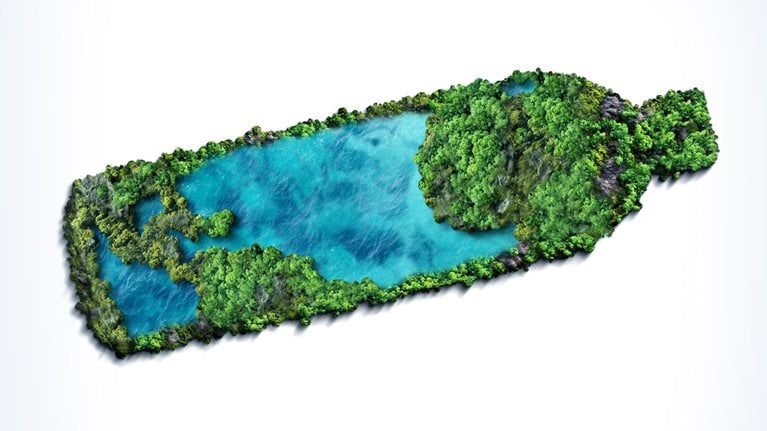
Consumers care about sustainability—and back it up with their wallets
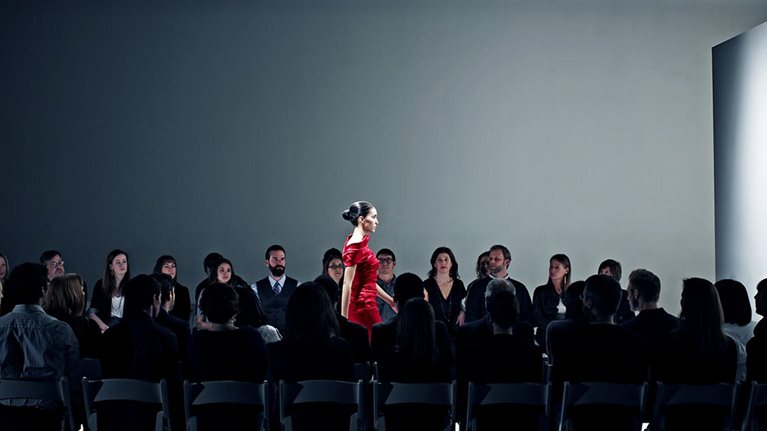
The State of Fashion 2024: Finding pockets of growth as uncertainty reigns
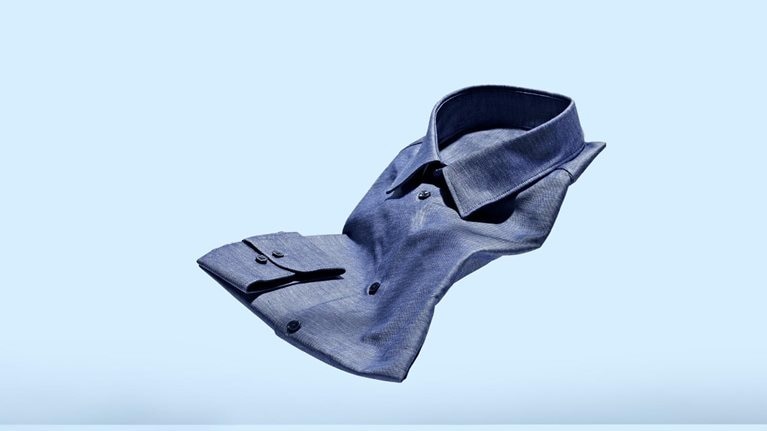
What is fast fashion?

The 10 Fall 2024 Trends That Will Be Everywhere This Year
The fall 2024 shows may have ended earlier this month, but the trends that emerged from the runways in New York, London, Milan, and Paris are still fresh on our minds. This season, designers focused on—and recast the idea of—womanly dressing. There were plenty of takes on ladylike fashion (prim house dresses at Miu Miu, fur-trimmed ones at Prada that were straight out of the 1960s) and feminine workwear. Some brands took the idea even further: Jonathan Anderson at Loewe turned the concept of everyday wearability on its head, while Bottega Veneta creative director Matthieu Blazy deconstructed a woman’s day through clothes, taking her from morning through the evening. Of course, there is not just one way to wear a femme style—leaving designers with unlimited options to create worlds of their own for the season. Below, we’ve listed our favorite 10 trends from fall 2024—which will be everywhere well before the leaves start to turn.
Brown Bear, Brown Bear, What Do You See?
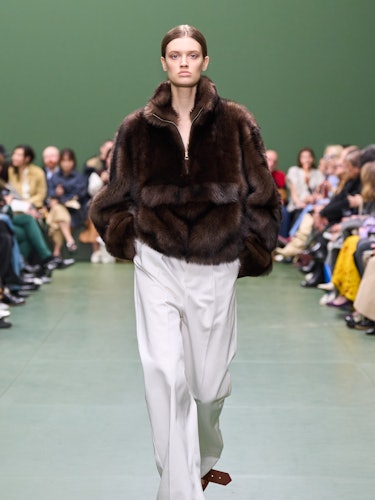
This season saw an incredible array of fur coats—what we loved most were the variations on beautiful brown furs. Loewe reimagined a sporty track jacket with a bit of softness in the form of a fun, large pouch on the front. Like Miu Miu, Celine made a ’60s-inspired coat with an exaggerated collar—both pieces you’d dream of nabbing from your grandmother’s closet. LaQuan Smith and Saint Laurent, meanwhile, created their own over-the-top versions.
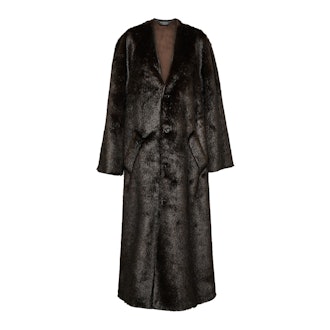
Make Way for Woman!

This trend was inspired by Blazy at Bottega, who said for fall 2024 he was interested in making clothes for every part of a woman’s day: work, commute, lunch, an outing with friends, a walk. This idea of elevated daywear felt sophisticated, comfortable, and easy in many of the collections. The trench coat from Burberry, jeans and a travel jacket at Chloé, and the classic barber jacket from Hermès are a few examples.
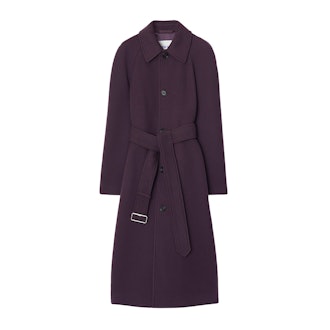
Ladies Who Lunch
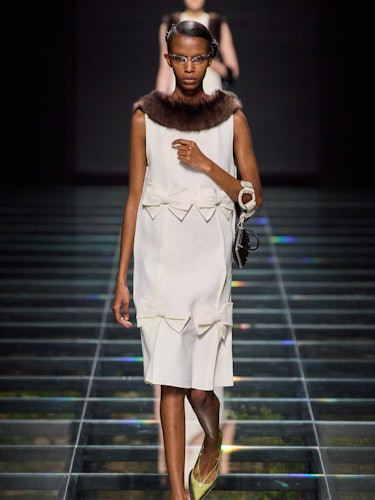
If you’re knee deep in (or have already binged) Feud: Truman Capote vs. The Swans , consider yourself more than familiar with this aesthetic. It’s easy to picture Babe Paley wearing any and all of these ladylike looks to lunch at La Côte Basque: like the flowing coatdresses at Chanel or the ’60s-inflected frocks at Prada, Miu Miu, and Celine.
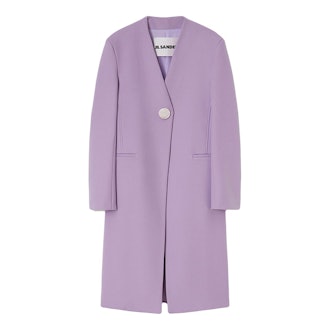
Poised Prep
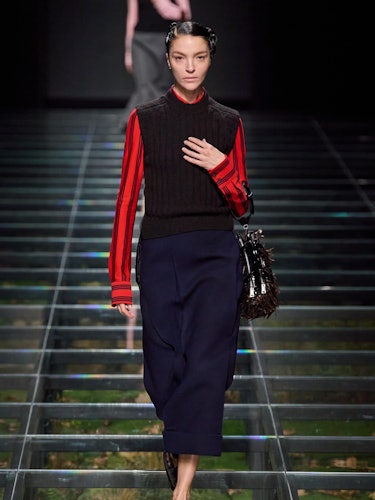
It feels like practically every season, we’ll see some kind of take on preppy style. But fall 2024’s version may be the best one we’ve encountered yet. The “Poised Prep” as we’re calling this character—whom we saw on the runways at Dries Van Noten, Prada, and Loewe— felt effortless, cool, and put-together. Upcycling master Hodakova reworked a knit polo, paired it with a pair of pants made into a skirt, and then flipped the whole thing upside down. Dries Van Noten, whose motto this season was about “style and not so much about fashion,” took your typical after-hours sweatsuit and made it sleek with a pink button-down peeking through the sleeves.
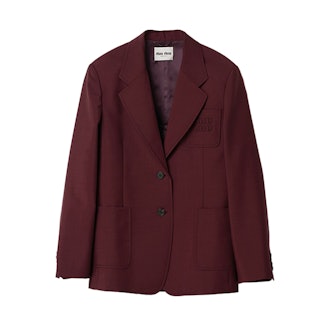
Plaid Girls Club
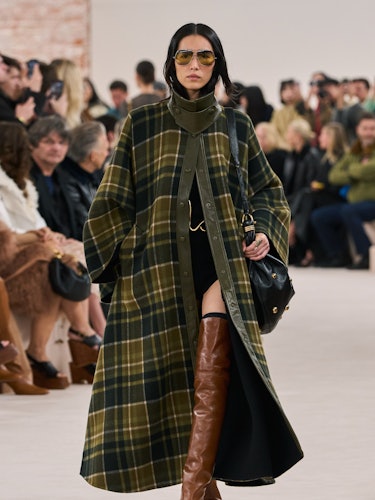
The ’90s grunge era may have been the last time that plaid took hold of the fashion public’s consciousness, but this fall could mark a serious comeback. Chemena Kamali’s debut collection for Chloé included the print in a long boho-esque coat, while Willy Chavarria put plaid on a Chicano maxi skirt.
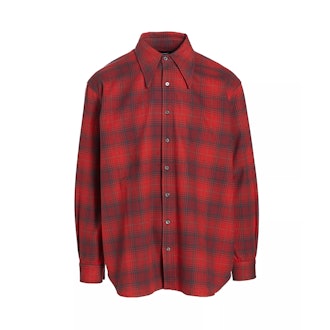
Leopard Gone Wild
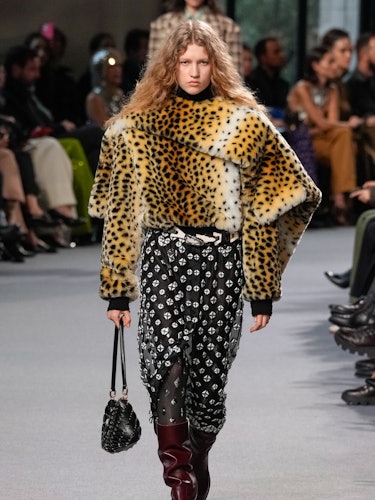
Leopard print has been making a slow and steady comeback over the past few seasons. And with fall 2024, we can officially say it’s running wild (sorry) on the runway. It certainly wasn’t difficult to spot! (We will stop, seriously.) Alaïa showcased leopard on a luxe knit top, while Marni put the print on a fabulous A-line dress. Michael Kors and Dior channeled leopard in elegant coats, and Celine, McQueen, Balenciaga, and Rabanne kept it furry and warm across the board.
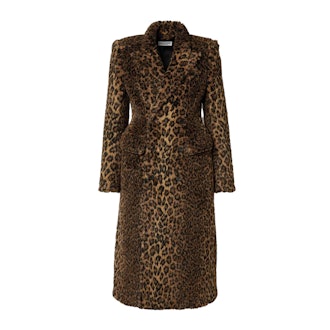
A Hill of Greens
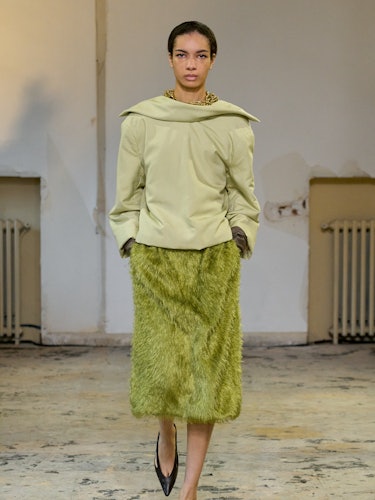
After multiple seasons of loud, bright red dominating the runways, the surprising color of fall 2024 was green—a hue known to symbolize new beginning and growth. This symbolism felt in tune with the running themes of “realness” and examinations of everyday wear, which we saw across the shows and presentations. Some brands like Loewe and Jil Sander went all out with the color, enveloping their guests in green-painted sets; others kept it subdued, like the Row and Saint Laurent. Miu Miu and McQueen made it quite apparent that this is the new color of the year—showing flashy neon hues that fashion fans won’t soon forget.

Princess & the Pea
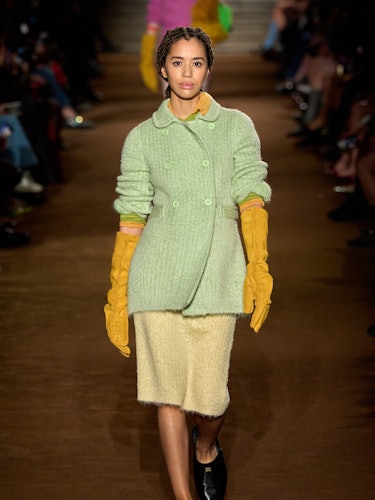
While there were no actual peacoats in Hans Christian Andersen’s classic fairytale, both the coat and the book did originate in the 1800s. Of course, this silhouette has been around for quite some time—and in 2024, it could be seen all over the runways. There were structured leather versions at Prada and Saint Laurent, a long and modern twist from emerging designer Aaron Esh, and a Mod silhouette at Gucci.
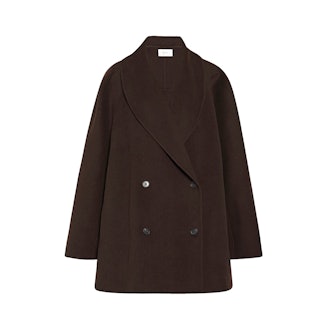
Puff, Puff, Pass
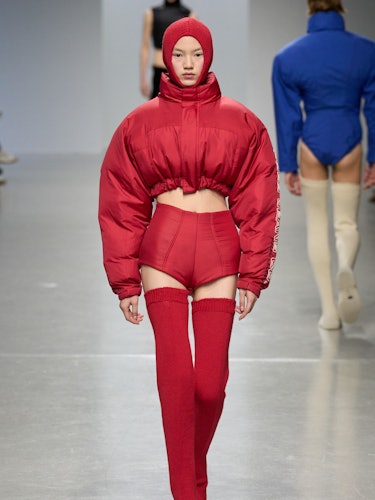
Sprinkled throughout the fur coat supremacy of fall 2024 was a range of puff coats and jackets that shined. We loved Jil Sander’s waxed burgundy version, Duran Lantink’s and Balenciaga’s red sets, and Miu Miu’s simple cropped jacket.
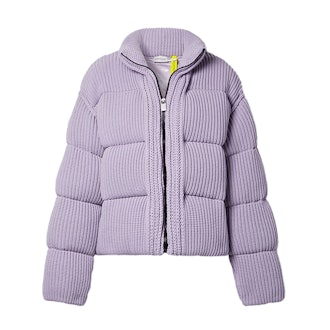
The New Moto
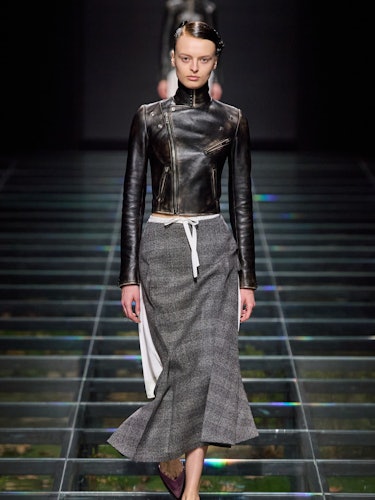
The moto jacket has been evolving since it was first created in 1913. Flash-forward to present day and it was all about moto this fall 2024, with each piece bearing its own twist. Prada made an elegant version that was the perfect combination of tough and delicate. Junya Watanabe deconstructed a jacket and made it into a work of art, while J.W. Anderson played with shape and color. At Coperni, one piece became an entire outfit—in the shape of a bodysuit.

- Washington State University
- Go to wsu twitter
- Go to wsu facebook
- Go to wsu linkedin
Second provost candidate on campus Thursday

The second of three candidates for the role of Washington State University provost will be visiting the Pullman campus tomorrow.
Candidate B will make a presentation to members of the WSU community from 1:20–2:10 p.m. Thursday, April 4, inside PACCAR 202. Their presentation will also be available to watch via Zoom , with a recording available for the following three days.
The names of the finalists as well as information about their work experiences and educational background, will be available on the Provost Search website the day before their presentations.
The final provost candidate is scheduled to make their presentations April 8. The first candidate made their presentation April 1.
Members of the university community will be able to weigh-in on the candidates via a survey that’ll become available following each presentation.

April is Financial Capability Month
Recent news.

Grant aims to better understand effects of classroom lighting on students

Jeff Walls wins early-career award

Diane Coughlin honored in naming of new welcome center

WSU fashion show celebrates the journey of student artisans

Showcase awards presented to undergraduate researchers

Fashion Cycles & the Consumer
Jul 11, 2014
290 likes | 620 Views
Fashion Cycles & the Consumer. HNB4MI. Review. With the person beside you determine the definition of Style Design Fashion You need to have a solid understanding of these terms from previous lessons before we can move forward. Lesson Objectives.
Share Presentation
- past design
- quite costly
- set time frame
- fashion cycle hand out
- specific fashion products
- reason fashion

Presentation Transcript
Fashion Cycles & the Consumer HNB4MI
Review • With the person beside you determine the definition of • Style • Design • Fashion • You need to have a solid understanding of these terms from previous lessons before we can move forward.
Lesson Objectives • Examine the fashion cycle as it relates to time and sales volume. • Learn that a relationship exists between the fashion cycle, consumer spending, and fashion acceptance. • Different consumer groups including fashion innovators, leaders, followers, and laggards are considered in relation to the fashion cycle and fashion acceptance. • Learn the meaning of fad, trend, fashion cycle
Style Recap • Remember what the word style means? A style refers to the unique characteristics of a garment. It is these unique characteristics that distinguish one garment or accessory from another. • Coats, skirts, dresses, and pants are all styles; however, there are many variations within each style group.
Treador Culottes Jodhpur Clam Digger Palozzo
Although this list provides a timeline of some pant style variations, what is important to remember is that the style of a garment never changes. Rather, what does change is the acceptance of a style by the consumer. • When a style is accepted and purchased by the majority of a consumer group it becomes fashion.
Laver’s Law
Why Does Fashion Change • As noted previously it is a consumer desire for new and innovative fashion is one reason fashion is constantly changing. • In fact, the notion of the changing nature of fashion is recognized in the numerous definitions of fashion. • To understand this changing nature of fashion you must look and study fashion within the context of the period in which it was produced, as fashion is always in harmony with the period in which it was created.
Hamilton’s Influences of Fashion Continuum
Fashion Industry as Initiator of Change: • Considering the fashion industry as the initiator of fashion change suggests that the industry dictates new fashion trends thus forcing change on the consumer. • Fashion houses in Paris as influencing and dictating consumer choices through the media. • Consumers have been known to reject new fashions that they believe have been forced on them.
Consumers as the Initiator of Change: • Many consumers love expressing themselves through their clothing choices regardless of what the fashion industry is promoting at that moment. • Considering the consumer as the initiator of change suggests that a group of consumers focus on specific fashion products which results in the development of specific fashion trends.
Four Theories that Explain Fashion Trends: • The upper socioeconomic (wealthy) consumer influences the beginning of fashion trends. • Fashion trends occur simultaneously within all socioeconomic groups. • Subcultures (e.g. hippies) influence the development of fashion trends. • Any creative and/or innovative individual can influence the development of fashion trends if their creations marry with the social climate of the period.
Consumers as Initiators of Change Continued: • Psychological reasons include the notion of diminished returns, as well as an understanding that consumers become bored with what they have and desire something new and exciting= artificial obsolesce. • Psychologicalreasons focus on consumer wants. • Rationalreasons focus on consumer needs. • For example, environmental needs have initiated change in fabric technology. The development of smart fabrics such as the UV screening fabrics is an example of a rational reason for initiating fashion change. • Social needs may also initiate rational reasons for change. For example, the “dress for success” phenomenon began when more women entered upper management and administrative positions during the 1980s.
Fashion Change is Gradual: • Although changes in fashion are constant, for example new fashions appear each season, these changes are by nature gradual. • Fashion change evolves. • It is this evolutionary rather than revolutionary process that provides the foundation for those who are involved in fashion forecasting and identifying fashion trends, as well as designers, stylists, and those who work in the area of fashion communication and marketing.
What is the Fashion Cycle? • The term fashion cycle refers to the acceptance of a style (remember the definition of the term style) • Beginning with the styles introduction, and moving through the styles growth, maturation, and eventual decline. • Styles that last for more than one season are considered fashion. • There is no set time frame for each style to move through the fashion cycle rather all styles go through the same stages of the fashion cycle regardless of the duration of their popularity.
Fashion Cycle & Fads • A style that is short-lived is called a fad. • Fads can typically be produced and sold at a lower price point and hence flood the market for a short period of time and move through the fashion cycle very quickly • The fashion industry is not particularly fond of fads as the money spent on the design, colour decisions, fabric selection, apparel and accessory production, and marketing can be quite costly and never recouped should the fad realize a quick demise. • Examples of fads include: • mood rings 70s/90s • leg warmers 80s/00s. • A fad that has stood the test of time can become a trend such as: White T-shirts, jeans
What are our FADS? • As a class lets aim to compile a list of TEN fads you have seen in your life time:
The Fashion Cycle: CLASSICS • A classic is a style that has staying power in the fashion cycle and hence the fashion industry. • A classic becomes a wardrobe staple. • Examples of a classic include: - jeans • white t-shirts • Blazer • trench coat
Turn to your Fashion Cycle Hand Out
Introduction • -One-of-a-kind • -Custom made • -Seen at Major designer • Fashion Shows • -“Avant Garde” (cutting edge)
Rise • -Accepted by more people • -Sold in exclusive stores • -Expensive • -Celebrities wear
Culmination • -Mass Produced • -Wore by most Consumers • -Ready-to-Wear • -Average, affordable price • -Malls, department stores etc.
Decline • -Sale Items • -End of Season • -e.g. Winners • -Sidewalk Sales
Obsolescence • -Discount Stores • -Liquidation price • -Wore by consumers • to whom fashion is not essential • -e.g. ‘What not to Wear”
Fashion Cycle & Trends: • A fashion trend refers to design and style ideas that major collections have in common and indicate the direction in which fashion is moving. • The trend may appear as a common silhouette, colour, or fabrication. • Styles enter, mature, and exit the fashion cycle simultaneously. • In other words, as one style is being introduced another is maturing, while another is on the decline. When a style has completed the fashion cycle it does not disappear forever. It eventually finds its way back into consumer favour often with a modern twist of a past design. • It may take from ten to more than fifty years for a style to return to the fashion cycle. • The reinterpretation and resurrection of styles from the past has become more common in the industry since 1995. Examples include the wrap dress popular in the 1970s which made a comeback for 2007/2008 and pointed pumps popular during the 1950s.
- More by User

Consumer and Business Buyer Behavior
Consumer and Business Buyer Behavior. Chapter 5. Road Map: Previewing the Concepts. Understand the consumer market and the major factors that influence consumer buyer behavior. Identify and discuss the stages in the buyer decision process.
1.64k views • 33 slides

CHAPTER 21. Consumer Protection. INTRODUCTION. This chapter explores the major acts that focus on consumer protection and fairness. Issues of consumer health and safety are also covered. Additionally, which agencies handle consumer issues is addressed. COMMISSIONS AND AGENCIES.
895 views • 47 slides
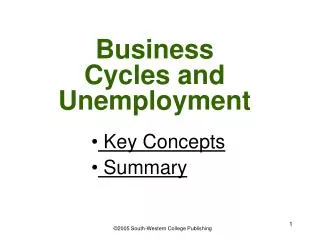
Business Cycles and Unemployment
Business Cycles and Unemployment. Key Concepts Summary. ©2005 South-Western College Publishing. This chapter will answer these questions:.
1.04k views • 60 slides
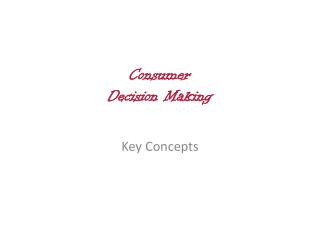
Consumer Decision Making
Consumer Decision Making. Key Concepts. Consumer Behavior. Processes a consumer uses to make purchase decisions, as well as to use and dispose of purchased goods or services; also includes factors that influence purchase decisions and the product use. Consumer Behavior.
1.17k views • 61 slides

The Theory of Consumer Behavior
The Theory of Consumer Behavior. The principle assumption upon which the theory of consumer behavior and demand is built is: a consumer attempts to allocate his/her limited money income among available goods and services so as to maximize his/her utility (satisfaction).
1.88k views • 7 slides

Session 5: Academic Medical Center Revenue Cycles
Session 5: Academic Medical Center Revenue Cycles. Session 5: Academic Medical Center Revenue Cycles. Part 1: Sponsored Research Revenue Cycle Part 2: Patient Care Revenue Cycle Part 3: Tuition Revenue Cycle. Session 4 - Financial Reporting. AGENDA. GOALS AND OBJECTIVES. Revenue Cycles
1.14k views • 85 slides

CONSUMER FINANCE
CONSUMER FINANCE. STUDY UNIT 3 How Financial Markets Work. Indiana Department of Financial Institutions Consumer Credit Education. INTRODUCTION.
1.43k views • 127 slides

New York Fashion Week
New York Fashion Week. By: Caylie Kruse. What is fashion week?. Fashion week is a week when designers put together fashion shows to release their latest creations. When is fashion week?.
2.14k views • 9 slides

Fashion from the 80s
Fashion from the 80s. Created by Jessica Matus. The audience is for Seventh and Eighth grade students that are taking a Family and Consumer Science Education Course. The students will be in a computer lab and they will be able to work at their own pace. . Objective.
1.47k views • 87 slides

GAMETOGENESIS & FEMALE CYCLES
GAMETOGENESIS & FEMALE CYCLES. OBJECTIVES. By the end of the lecture, the students should be able to: Define gametogenesis. Differentiate the types of gametogenesis. Describe the process of spermatogenesis. Describe the process of oogenesis. Describe the female cycles (Ovarian & Uterine).
1.41k views • 31 slides

Color in Fashion Chapter 9, Clothing, Fashion, Fabrics & Construction
Color in Fashion Chapter 9, Clothing, Fashion, Fabrics & Construction. Human eye sees 6-7 million colours Figure 9.4, 9.5 Colour is used in fashion by the buyer, co-ordinator, designer, fashion writer or consultant Colour and Clothing
1.67k views • 29 slides
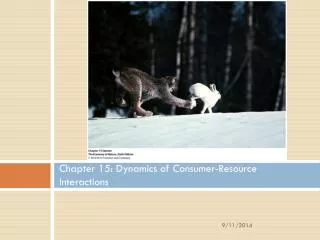
Chapter 15: Dynamics of Consumer-Resource Interactions
Chapter 15: Dynamics of Consumer-Resource Interactions. Population Cycles of Canadian Hare and Lynx. Charles Elton’s seminal paper focused on fluctuations of mammals in the Canadian boreal forests. Elton’s analyses were based on trapping records maintained by the Hudson’s Bay Company
883 views • 76 slides

Adopting new trends with wholesale fashion jewelry
Wholesale Jewelry Palomar Fashion offers the best selection and lowest prices on wholesale fashion and costume jewelry Shop our selection and save!
1.15k views • 18 slides

Nutrient Cycles, Bioremediation, and Symbioses
Chapter 24. Nutrient Cycles, Bioremediation, and Symbioses. I. The Carbon and Oxygen Cycles. 24.1 The Carbon Cycle 24.2 Syntrophy and Methanogenesis. 24.1 The Carbon Cycle. Carbon is cycled through all of Earth’s major carbon reservoirs
1.88k views • 147 slides

3. CHAPTER. Consumer Decision Making. The Importance of Understanding Consumer Behavior. LO 1. Explain why marketing managers should understand consumer behavior. “Ultimate” consumers who buy goods and services for their own personal or household use. The Consumer Market.
992 views • 65 slides

Calvin Klein American Fashion Designer 1968 - present
Calvin Klein American Fashion Designer 1968 - present. Dana Boyd. Born in Bronx, NY in 1942. Attended High School of Art & Design Studied Fashion at FIT in NYC. Calvin Klein, Inc. A large global brand with strong consumer recognition. 1970’s Jacket, blouse and skirt.
3.39k views • 15 slides

Global change
Global change. Natural short and long term changes Anthropogenic changes. Natural cycles. Glacial cycles Holocene climate variability Orbital cycles Milankovitch cycles – regular shifts in earth’s climate. Glacial-interglacial. Relationship between glacial-interglacial cycles and CO 2
944 views • 56 slides

6. Thermodynamic Cycles
6. Thermodynamic Cycles. Objective Classification of Thermodynamics Cycles Analysis & Calculation of Power Cycles Carnot Vapor Cycle, Rankie Cycle, Regeneration Rankie Cycle,Reheat Rankie Cycle Cogeneration Gas Refrigeration Cycle Vapor-Compression Refrigeration Cycle Refrigerant
1.72k views • 61 slides

INTRO TO CONSUMER BEHAVIOR
INTRO TO CONSUMER BEHAVIOR. Marketing Concept. A consumer-oriented philosophy that suggests that satisfaction of consumer needs provides the focus for product development and marketing strategy to enable the firm to meet its own organizational goals. Consumer Behavior.
1.39k views • 95 slides

Cultural Integration
Cultural Integration. Syllabus. the diffusion, adoption and adaptation of mass consumer culture reflected in media, fashion, brand images, sport, music and religion
1.29k views • 79 slides

Fashion History
Fashion History. 1900’s – 1950’s. Fashion Evolution & Assignment. Fashion is always changing! Fashion changes are due to a number of societal factors- Politics, Economy, War, Human Rights...
1.28k views • 37 slides

WELCOME TO BULK BILLING
WELCOME TO BULK BILLING. PRESENTATION. First Screen after Login. Consumer Master. New Consumer Entry. Consumer Master. Contact Details Entry. Consumer Master. View Consumer Profile. Consumer Master. Address Change. Consumer Master. Load Changes. Consumer Master.
1.48k views • 108 slides
Got any suggestions?
We want to hear from you! Send us a message and help improve Slidesgo
Top searches
Trending searches

solar eclipse
25 templates
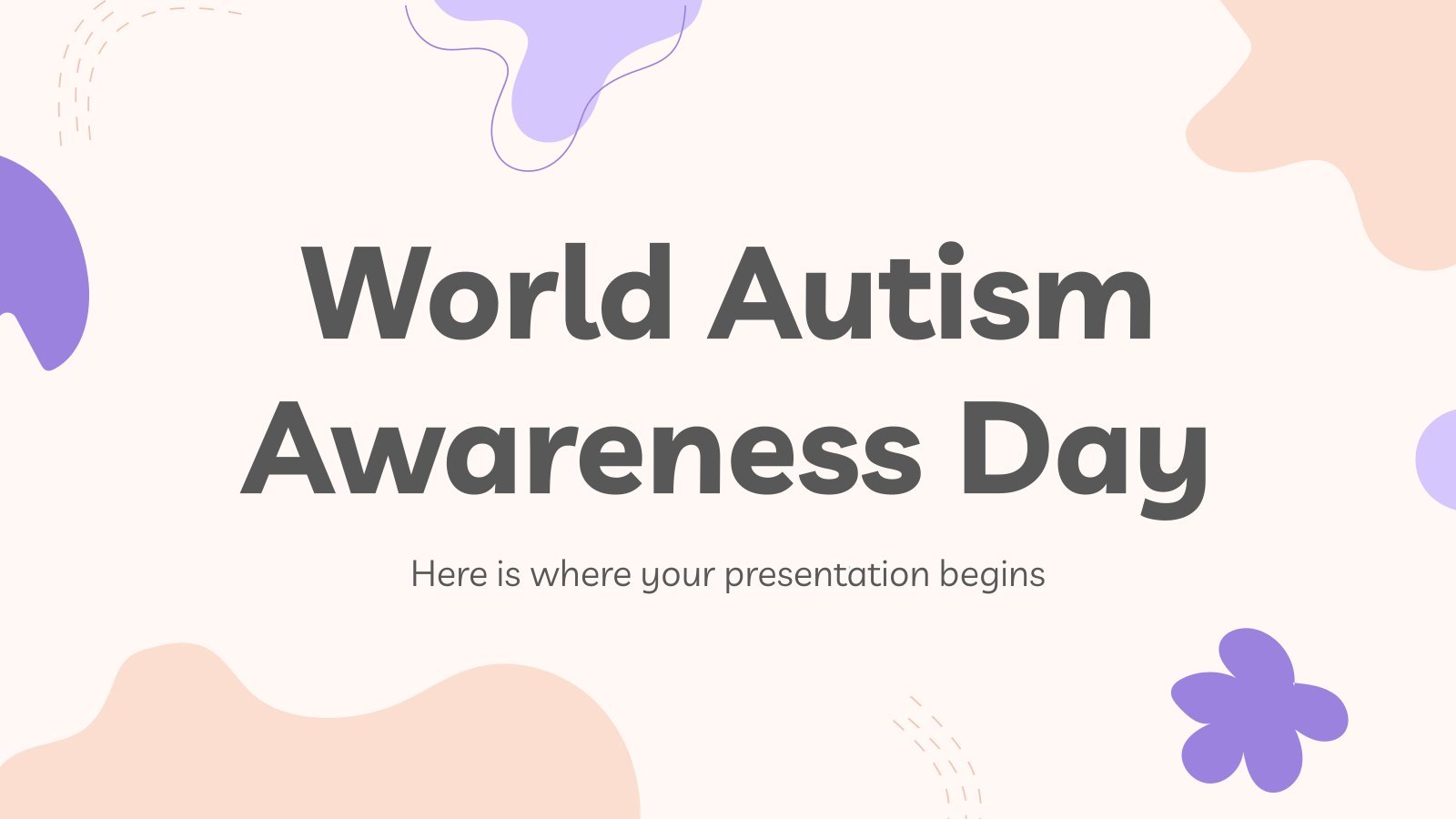
autism awareness
28 templates

26 templates

16 templates

6 templates

32 templates
Travel Guide: Moscow
Travel guide: moscow presentation, free google slides theme and powerpoint template.
Do you know some acquaintances that want to travel to Russia, the biggest country in this planet? Now you can be their own tour guide with this template. Include as much information as possible about tourist attractions, monuments and things to do in Moscow. Let the simplicity of these slides and their cool illustrations speak in favor too!
Features of this template
- 100% editable and easy to modify
- 25 different slides to impress your audience
- Contains easy-to-edit graphics such as graphs, maps, tables, timelines and mockups
- Includes 500+ icons and Flaticon’s extension for customizing your slides
- Designed to be used in Google Slides and Microsoft PowerPoint
- 16:9 widescreen format suitable for all types of screens
- Includes information about fonts, colors, and credits of the free resources used
How can I use the template?
Am I free to use the templates?
How to attribute?
Attribution required If you are a free user, you must attribute Slidesgo by keeping the slide where the credits appear. How to attribute?
Related posts on our blog.

How to Add, Duplicate, Move, Delete or Hide Slides in Google Slides

How to Change Layouts in PowerPoint

How to Change the Slide Size in Google Slides
Related presentations.
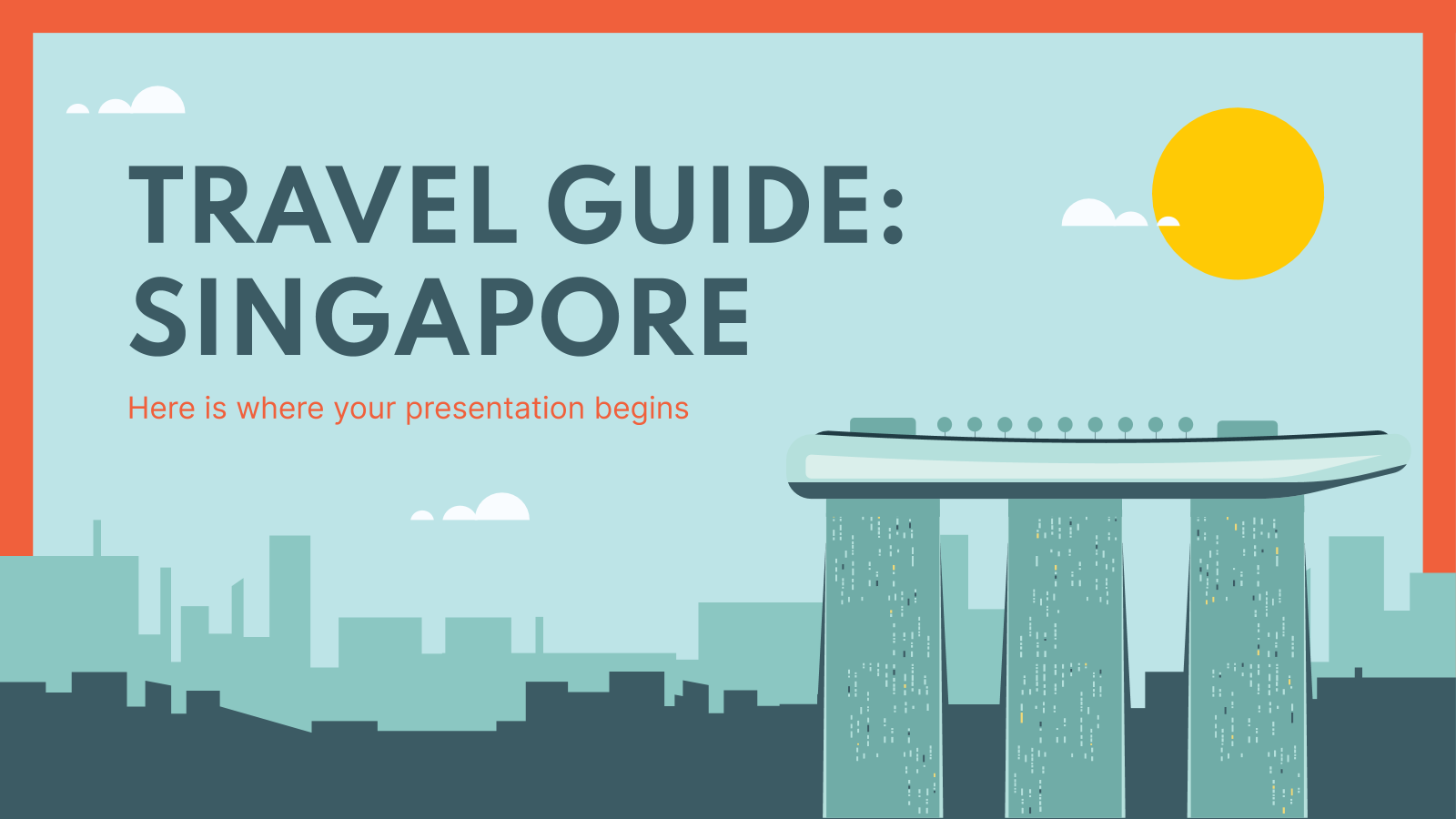
Premium template
Unlock this template and gain unlimited access
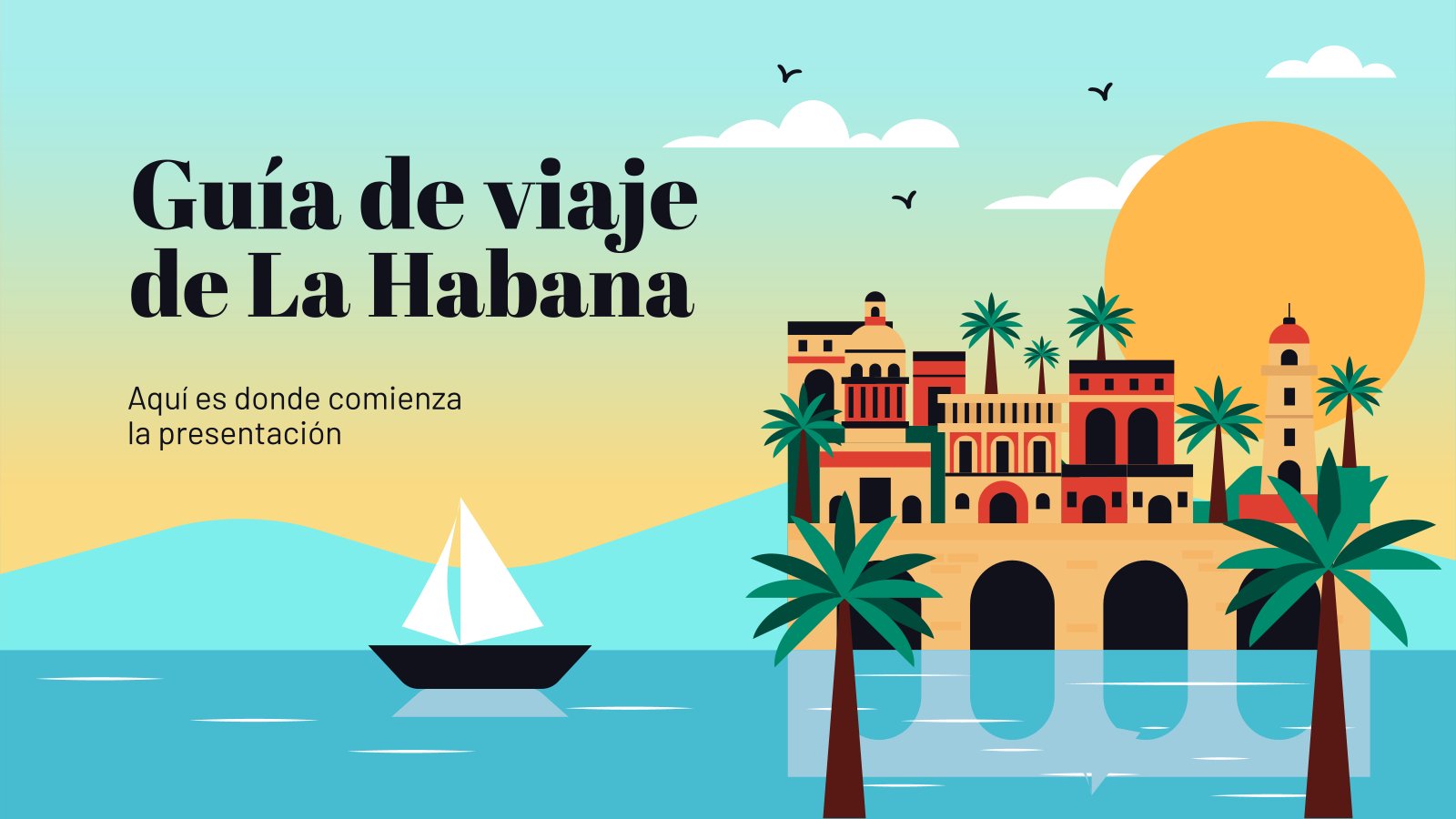

IMAGES
VIDEO
COMMENTS
Here is a breakdown of the five stages in a standard fashion cycle: 1. Introduction: The introduction stage is when the new style first enters the fashion world. This introduction can be part of a new haute couture design during fashion week, an outfit worn by a well-known figure, or a calculated effort from a marketing agency or manufacturer.
Fashion moves through different stages during its cycles of existence. Fashion acceptance is generally called as a fashion cycle. The fashion cycle is usually represent as a bell shaped curve with 5 stages. Introduction. Rise in popularity. Peak of popularity. Decline in popularity. Rejection. Figure: Stages of fashion cycle.
Presentation Transcript. The Fashion Cycle. Fashion Cycle: • The period of time or life span during which the fashion exists. Peak Decline Rise Introduction Obsolescence. Introduction Stage • Designs first previewed during fashion week • "Fashion Leaders" wear the style • Limited number of people purchase • High Price.
Stages of the Fashion Cycle • Fashion moves through different stages during its cycle of existence. • Not only design but special features also go through a cycle such as color, texture, and fabric. Introduction Stage • Designs first previewed during fashion weeks at the major design centers • New styles, colors, or textures are ...
A fashion trend's life cycle can be divided into five stages, generally speaking: introduction, rise, peak, decline, and obsolescence. The life cycles of fashion trends today have changed; technology and social media have rendered them much shorter and less predictable than in the past. Luxury and fast-fashion brands move through the trend ...
3 What is the fashion cycle? Fashion cycle - a period of time or life span during which the fashion exists, moving through the five stages from introduction through obsolescence. When a customer purchases and wears a certain style, that style is considered accepted. The acceptance leads to the style becoming a fashion!
4 Stages of the fashion cycle (cont.) Introduction: The first stage of the fashion cycle when new styles, colors, textures, and fabrics are introduced. The new style may be accepted by a small number of people called fashion leaders. Promotional activities include fashion shows and advertising in high fashion magazines.
Presentation Transcript. Definition • Fashion cycles refer to the five stages a fashion goes through from conception to death. (fashion cycles can be compared to a wave) • Stages of the Fashion Cycle • Introduction • Rise • Acceleration • Culmination • Decline • Obsolescence. Fashion is a Mirror of the Times • Each new fashion ...
Fashion Cycle and Theories - Free download as Powerpoint Presentation (.ppt), PDF File (.pdf), Text File (.txt) or view presentation slides online. Fashion cycles and various fashion theories that evolved with time
Presentation on theme: "Fashion Cycle."— Presentation transcript: 1 Fashion Cycle. 2 What is the fashion cycle? An ongoing rise, peak, and fall in popularity of specific styles Every style rotates through the cycle Fashion good- colors, textiles, and fabrics Products, cars, etc. Everyone's wearing ...
fashion cycle ppt - Free download as Powerpoint Presentation (.ppt / .pptx), PDF File (.pdf), Text File (.txt) or view presentation slides online. Scribd is the world's largest social reading and publishing site.
The new fashion could be an effort of forecast presentation by a marketing agency or manufacturer. ... fabric, line, sharp, and trimming. 2) Increase in fashion cycle or fashion acceptance . This is the second stage of the cycle known as Growth in Popularity also. When celebrities wear a new dress and then if mass people is influenced or it ...
About This Presentation. Title: The Fashion Cycle. Description: ... styles Less expensive fabrics used to create similar style at cheaper prices More people wear the fashion = higher sales Peak Stage Fashion ... funny 50 years ... - PowerPoint PPT presentation. Number of Views: 3420. Avg rating:3.0/5.0.
Fashion Cycle (3) - Free download as Powerpoint Presentation (.ppt / .pptx), PDF File (.pdf), Text File (.txt) or view presentation slides online. Scribd is the world's largest social reading and publishing site.
Fashion brands, big and small, have made ambitious, public commitments to creating more sustainable apparel by 2030. But keeping pace with their decarbonization commitments has been a challenge across the industry. About two-thirds of brands, according to a new McKinsey analysis, are behind on their own decarbonization schedules, and 40 percent have seen their emissions output increase since ...
The fall 2024 shows may have ended earlier this month, but the trends that emerged from the runways in New York, London, Milan, and Paris are still fresh on our minds.
Presentation Transcript. The Fashion Cycle Graph • A style moves through stages from the time it is introduced until consumer interest in the style ends. The time lapse for this cycle is not the same for every style. Style • Style refers to the characteristics that distinguish one particular item of clothing from another.
Walking tour around Moscow-City.Thanks for watching!MY GEAR THAT I USEMinimalist Handheld SetupiPhone 11 128GB https://amzn.to/3zfqbboMic for Street https://...
Their presentation will also be available to watch via Zoom. Candidate B will make a presentation to members of the WSU community from 1:20-2:10 p.m. Thursday on the Pullman campus. Their presentation will also be available to watch via Zoom. ... WSU fashion show celebrates the journey of student artisans April 3, 2024.
A business session of the largest specialized exhibitions in Russia will be held on 27 - 30 August 2024 in Moscow City (Afimall) and Expocentre. The business events will include all areas of the textile and fashion industry: TEXTILE SALON - fabrics and accessories for garment production (organizer - Expo Fashion)
Presentation Transcript. Fashion Cycles & the Consumer HNB4MI. Review • With the person beside you determine the definition of • Style • Design • Fashion • You need to have a solid understanding of these terms from previous lessons before we can move forward. Lesson Objectives • Examine the fashion cycle as it relates to time and ...
Orchestra Presentation. One of the best and top requested orchestras in Russia, Moscow City Symphony "Russian Philharmonic", performs with great success in the largest concert halls in Russia and abroad. This is the only orchestra that plays the music of various styles and genres from classical to rock at the highest professional level.
Disney Templates with your favorite Disney and Pixar characters Slidesclass Ready-to-go classes on many topics for everyone Editor's Choice Our favorite slides Teacher Toolkit Content for teachers Multi-purpose Presentations that suit any project Interactive & Animated Templates to create engaging presentations